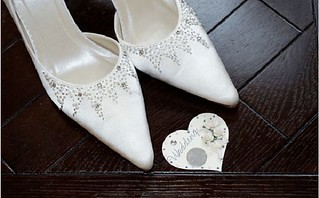
About UsThe Numismatic Bibliomania Society is a non-profit organization promoting numismatic literature. For more information please see our web site at coinbooks.org SubscriptionsThose wishing to become new E-Sylum subscribers (or wishing to Unsubscribe) can go to the following web page link MembershipThere is a membership application available on the web site Membership Application To join, print the application and return it with your check to the address printed on the application. Membership is only $20 to addresses in the U.S., $25 for First Class mail, and $30 elsewhere. For those without web access, write to: David M. Sundman, Treasurer AsylumFor Asylum mailing address changes and other membership questions, contact David at this email address: dsundman@LittletonCoin.com SubmissionsTo submit items for publication in The E-Sylum, just Reply to this message, or write to the Editor at this address: whomren@gmail.com
BUY THE BOOK BEFORE THE COIN |
- WAYNE'S WORDS: THE E-SYLUM SEPTEMBER 21, 2014
- NEW BOOK: ENCYCLOPEDIA OF MEXICAN MONEY
- NEW BOOK: A CATALOGUE OF ANGLO-GALLIC COINS
- HARDBOUND COUNTERFEIT PORTRAIT EIGHT-REALES
- BOOK REVIEW: NEW JERSEY STATE COPPERS
- BOOK REVIEW: RAYMOND’S COINS OF THE WORLD
- SELECTIONS FROM SKLOW LITERATURE SALE #23
- THE JOURNAL OF NUMISMATIC RESEARCH
- THE RED BOOK KNOCKOFF PUBLISHING DATE
- NOTES FROM E-SYLUM READERS: SEPTEMBER 21, 2014
- ATTRIBUTING 1861-O HALF DOLLAR VARIETIES
- CONFEDERATE CURRENCY PRINTERS LEGGETT, KEATINGE & BALL
- CHRISTMAS TREE COIN HOLDER HOARD FOUND
- COINWEEK INTERVIEWS MIKE CASTLE
- LONG-MISSING INVERTED JENNIES SOUGHT
- ODYSSEY MARINE SUSPENDS SS CENTRAL AMERICA OPERATIONS
- JOHN QUINCY ADAMS TWEETS FROM BEYOND THE GRAVE
- MORE ON VAIL MEDAL RECIPIENT JOSEPHINE AUGUST
- SOME INTERESTING MEDALS: SEPTEMBER 21, 2014
- OCR AND NON-LINEAR LEGEND ORIENTATIONS
- QUIZ: WHO HAD ALL VARIETIES OF 1793 CENTS?
- THE LIFE AND WORK OF CHESTER BEACH
- CLASSICAL NUMISMATIC GROUP LONDON OFFICE MOVING
- NEWMAN CHALMERS THREEPENCE, SIXPENCE AND RINGS
- WILLIAM WEIMER
- EMPEROR NORTON'S GARDEN PARTY
- QUERY: SAMUEL JOHNSON'S GOLD MEDALLION
- BULGARIAN FIND OF ANCIENT ELECTRUM COIN FROM LYDIA
- 3D PRINTED BOOK OF BAS RELIEF
- MORE ON REPLACEMENT BANKNOTES
- REPLACING DAMAGED IRISH BANKNOTES
- WEDDING COIN TRADITIONS
- COIN-FILLED LUCITE TOILET SEAT
- FEATURED WEB PAGE: ORDERS AND MEDALS RESEARCH SOCIETY
Click here to access the complete archive
To comment or submit articles, reply to whomren@gmail.com
WAYNE'S WORDS: THE E-SYLUM SEPTEMBER 21, 2014

New subscribers this week include: Maria Goodwin of the U.S. Mint, G. Ziss, Ron Spieker and Edmund Goldshinsky. Welcome aboard! We now have 1,772 subscribers.
First, welcome and thanks to two new advertisers, Fred Weinberg and Hedley Betts. Thank you for your support. This week we open with two new books, two book reviews, and a look at selected lots from the upcoming Sklow numismatic literature sale.
Other topics include the Journal of Numismatic Research, Confederate currency printers Leggett, Keatinge & Ball, Chester Beach, William Weimer, replacement notes, wedding coin traditions and Emperor Norton's garden party.
To learn more about Wayte Raymond’s Coins of the World, William Blades' Numismata Typographica, Lithuanian Love Coins, Samuel Johnson's gold medallion, and why a Welshman, a Dane and an American have written a book about Anglo-Gallic coins, read on. Have a great week, everyone!
Wayne Homren
Editor, The E-Sylum

NEW BOOK: ENCYCLOPEDIA OF MEXICAN MONEY
 Whitman Publishing announces the release of the first volume of the Whitman Encyclopedia of Mexican Money, by Don and Lois Bailey. The 496-page hardcover book debuts in September 2014. It is available from booksellers and hobby shops nationwide, and online (including at www.Whitman.com), for $39.95. The book can also be borrowed for free as a benefit of membership in the American Numismatic Association, through the Dwight N. Manley Numismatic Library.
Whitman Publishing announces the release of the first volume of the Whitman Encyclopedia of Mexican Money, by Don and Lois Bailey. The 496-page hardcover book debuts in September 2014. It is available from booksellers and hobby shops nationwide, and online (including at www.Whitman.com), for $39.95. The book can also be borrowed for free as a benefit of membership in the American Numismatic Association, through the Dwight N. Manley Numismatic Library.
Volume 1, the first book in the four-volume Encyclopedia, is an introduction for collectors and historians—an overview and history of Mexican coinage and currency, richly illustrated with 1,182 images. It was written by award-winning scholars Don and Lois Bailey with the cooperation of numerous collectors, coin dealers, museum curators, government officials, bank officers, and other experts. It covers pre-Columbian money to the colonial era, the independence movement, revolutions, modern coinage reforms, commemorative programs, and silver, gold, and platinum bullion.
Volume 1 covers all regular coinage issues by type, with years, mintmarks, assayers, and relevant comments; plus confirmed die varieties. It catalogs Mexican coinage with the comprehensive new Bailey-Whitman (BW) numbering system, cross-referenced to older systems. The Whitman Encyclopedia includes many coins unlisted in earlier reference books.
A new, specially designed font system for Mexican mintmarks improves on earlier, less accurate typographical treatments.
In addition to coins, volume 1 explores Mexican primitive money, patterns, tokens, sets, orders and decorations, medals, paper money, and other specialized numismatic topics.
Additional resources for collectors and researchers include charts of the precious-metal content (and resulting bullion values) of Mexican coinage going back to the first milled coinage of 1732; a glossary of terms relevant to Mexican and general numismatics; a bibliography; and an index.
“Everyone interested in the history and coinage of Mexico will find this book enjoyable and comprehensive,” said Dr. Manuel Galán Medina, retired Director General of Currency Issues for the Banco de México.
Future volumes in the Whitman Encyclopedia of Mexican Money will focus on the following topics in even greater detail, with more photographs, coin values, and information: modern coinage of the reforms of 1905 and 1992 (volume 2); media of exchange from pre-Columbus days through Republican decimal coinage (volume 3); and the coins and tokens of the 1910–1920 Mexican Revolution (volume 4).
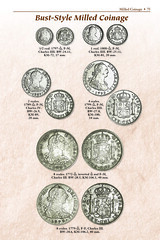
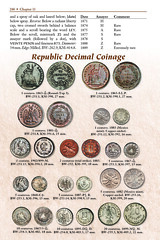
About the authors:
Born and reared in south-central Michigan, Don Bailey joined the Marine Corps during the Korean War. When he retired from the Marines, he lived in Yuma, Arizona, where he was introduced to the vastly interesting history of Mexico. He started collecting U.S. coins in the early 1960s, but soon turned exclusively to Mexican numismatics, concentrating at first on the coinage of Maximilian and the French Intervention. Since 1979 he has been very active in the Mexican numismatic field as a full-time dealer, attending most of the major coin shows in the United States and Mexico. His wife, Lois, has been his full-time business and research partner.
In 1967, Don started the Maximilian Numismatic and Historical Society. He published his first article, on the subject of Mexican numismatics, that same year. Since then he has written on other subjects (including the story of the 1980s forger and murderer Mark Hoffman), but Mexican history and numismatics have always been his focus. He has written articles and columns for World Coin News, Coin World, and other publications, and served as Coin World’s “Mexican Trends” analyst. He has also been a contributor to major references on Mexican numismatics, including the Standard Catalog of Mexican Coins, Standard Catalog of World Coins, and Tokens of Latin America; Frank W. Grove’s numerous volumes on medals, decorations, and tokens of Mexico; and the Guide Book of Mexican Coins, by T.V. Buttrey and Clyde Hubbard, to name a few.
Don has been a member of, and an officer in, many numismatic organizations. He is a life member of the American Numismatic Association and has been a member of the Sociedad Numismatica de México for more than 40 years, serving for a number of those years as the society’s official representative in the United States. He has worked with the Banco de México and the Casa de Moneda de México to promote their products and numismatic materials, and in 1974 he was appointed to the U.S. Assay Commission. Don has been the recipient of the ANA’s Presidential Award, the Sociedad Numismatica’s José Tamborrel Jr. Award (twice), and the Sociedad’s Alberto Francisco Pradeau Award. Numismatic News named him a Numismatic Ambassador in 1980. On September 27, 2001, Don received the Orden Mexicana del Águila Azteca (Mexican Order of the Aztec Eagle), the highest honor bestowed on a foreigner by the government of Mexico.
In June of 1997, Don, Joe Flores, and Sal Falcone organized the United States Mexican Numismatic Association, and Don served for many years as its executive director and the editor of its quarterly publication, the Mexican Numismatic Journal. The Sociedad Numismatica honored the association with the Dr. Alberto Francisco Pradeau award for promoting Mexican numismatics.
According to Don, “These fifty years have been a ball. Fifty years of working, if one can use that term, in a field that you really enjoy is all that you can ask. My wife, Lois, is a vital part of the operation. Without her assistance and encouragement the goals we have achieved would have been impossible to reach.”
Whitman Encyclopedia of Mexican Money, volume 1
By Don and Lois Bailey; foreword by Dr. Manuel Galán Medina, retired Director General of Currency Issues for the Banco de México
ISBN 0794834074
Hardcover, 6 x 9 inches, 496 pages, full color
Retail $39.95 U.S.
For more information, or to order, see:
Whitman Encyclopedia of Mexican Money, Volume I
(www.whitman.com/store/Inventory/Detail/Whitman-Encyclopedia-of-Mexican-Money-Volume-I+0794834078)
NEW BOOK: A CATALOGUE OF ANGLO-GALLIC COINS
A CATALOGUE OF ANGLO-GALLIC COINS of Aquitaine, Bergerac, Issoudun, Ponthieu and Poitou and the Royal coins of Henry V and VI.
The collecting of Anglo-Gallic was brought to the notice of those who collected coins in A Series of above Two Hundred Anglo-Gallic or Norman and Aquitan Coins of the Antient Kings of England; Exhibited in Sixteen Copper-Plates, and Illustrated in Twelve Letters, Addressed to the Society of Antiquaries of London, and several of its Members written by Andrew Coltee Ducarel, and published and sold in 1757 by E Withers who operated from the Seven-Stars, between the Temple-Gates, in Fleet-Street. It would be nice to think that he was an ancestor of mine, but it is most unlikely.
Ducarel, who had been born in Normandy in 1713, was referring to the fact that between 1154 and 1453 the Plantagenet kings of England had interests in France, and the so-called ‘Anglo-Gallic’ coins are the results of coining in those areas by English monarchs in their various capacities as Duke, or Prince of Aquitaine, Earl of Poitou, or count of this, that, or the other.
Ducarel derived much from several books including Les figures des monnoyes de France by Jean Baptiste Haultin in 1619 and especially the Abbé Venuti’s Dissertation historique sur les monoyes que les Anglais ont frappées en Aquitaine, et dans d’autres Provinces de France, published in 1754. Of considerable importance too was Claude Gros de Boze, keeper of the French royal collection of coins, whom Ducarel met in Paris and with whom he later corresponded. Boze had, in 1752, published his work on French feudal coins Monnoyes des prelats & barons de France, which contained much that was of use to later authors.
In the late 1700s Edward Hawkins began to compile a catalogue of the coins that were then in the collection of the British Museum. It was published in 1826. Just four years later George R Ainslie published his opus magnum on the subject, though for some reason best known to himself, did not to put his name on it ! Ainslie preferred the description ‘Anglo-French’ coins to that of ‘Anglo-Gallic’.
The next advance came about eighty years later, when a well-researched series of articles by Lionel M Hewlett began to appear in the Numismatic Chronicle. These were made available to a wider public in 1920, when A H Baldwin and Sons published them in one volume, providing a catalogue of the then known coins that was easy to read and use and contained the latest thoughts and advances.
For sixty years Hewlett’s book remained the standard reference on the subject, and is still worth reading today. However, like all good books, it eventually went out of print and became difficult to find.
In 1984, Spink published The Anglo-Gallic Coins, by E R Duncan Elias, a collector and enthusiast. He had been researching and collecting since the early 1960s and possibly even before that. He was a Dutchman who spoke excellent English and was a visitor to BANS congresses for several years.
Now, although 1984 does not seem, to some of us, to be a long time ago, thirty years is nevertheless almost half a life time, and it is high time to take advantage of the immense progress made by photography, computers, communication, typesetting and printing, and Galata Print is now getting very close to publishing a new book on the subject.
The authors, Paul and Bente Withers, and Steve Ford, have been researching and/or collecting Anglo-Gallic coins for a dozen years or longer and during that time enjoyed access to major and minor museums at home and abroad, dealers and auction houses, and were allowed to photograph most important public collections and many private ones. For more than a decade thousands of coins have been photographed and recorded, old books and auction catalogues consulted, and the internet trawled.
The result is a catalogue raisonnée of all known types and varieties of gold, silver and billon coins, including around 36 types and hundreds more minor varieties that were not known to Elias. Apart from the major types which Elias did not know, an exact count of the minor varieties is not possible because the items are catalogued in a different way from Elias’ work; however, there are many of them.
Using their numismatic and other skills the authors have taken the opportunity to correct errors, some of which are 30 years, and others almost 300 years old. Numerous additions and revisions have been made and the work now includes over 560 1:1 high quality colour illustrations, 280 double life-size enlargements of important features to help identification, and in addition 80 line drawings and a map – all thoughtfully and carefully presented so as to make the information more accessible to collectors, students, numismatists, dealers, and archaeologists than it has been. The information has been presented visually so that the French reader will understand it almost as well as the English reader.
This is to be compared with Elias’ 204 B&W 1:1 illustrations and 39 line drawings.
One of the problems bedeviling English numismatics for many years until the scientific study of numismatics began was the fact that English kings had no imagination when naming their sons. Thus, it is difficult to separate a series of Henries and Edwards. Whilst this has largely been done for the English series, the problems have not been conclusively solved for Anglo-Gallic coins, and there are other problems peculiar to the series.
However, the authors have carefully considered the latest hoards and discoveries and the question of which coins were minted during the reign of Edward II and those struck during the reign of Edward III. This has resulted in the reattribution of many coins. The reasoning behind the changes has been carefully explained in the text. There have also been changes of the order of the coins as perceived by Elias, so as to present them in chronological order.
Major changes have been made to the section on the coins of Bergerac minted by Henry of Lancaster, both as count and duke. No fewer than seven new types are recorded, and many dozens of sub-varieties.
The work includes an extensive bibliography of works in English and French, compiled by Steve Ford in conjunction with Andy Singer.
Also included is a time line of events in England, France and the rest of the World which some people may find thought-provoking. There is a section on lettering, which is not just for the beginner. Another section on how to identify coins. A chapter is devoted to a listing of marks other than letters, including types of crosses found in the book, mint marks, punctuation, issue marks, other secret marks and their possible meanings. The denominations are all discussed, together with the origins of their names.
Each type and sub-variety of coin is accorded a rarity rating and a table of rarity explains the how they are given. Legends are given for each obverse and reverse, and the combinations in which they occur are given. Highest and lowest known weights are listed.
The authors, listed in chronological order, are: Paul Withers, Bente R Withers and Steve Ford.
The Story of the Book
Readers may well wish to know why a Welshman, a Dane and an American have written a book about Anglo-Gallic coins ?
Why indeed ? But there are plenty of equally strange mis-matches of collecting field and nationality. The standard general reference work on German States coins, for example was written not by a German, but by an American and the standard reference on the coinage of the Anglo-Hannoverian Personal Union 1714-1837 was written, again, not by a German, but by an Englishman. Sometimes, citizens of a particular country have been woefully inadequate when it comes to writing about the coins of the land of their birth.
My own stimulus for writing this book came because I had met, several times, the late Edward Elias at British Association of Numismatic Societies congresses. Two friends who have since passed away, David Rogers and Roderick Palmer, both of whom collected Anglo-Gallic coins, were always finding minor varieties of coins that were not listed by Elias in his book. Then there was Peter Woodhead, a most hospitable gentleman, who after dinner one evening showed us some of his collection. Then, aided by the spirit of a good bottle of wine, an idea struck, why not publish a “Galata Guide” on Anglo-Gallic coins to help collectors. This was because Elias’ Anglo-Gallic Coins was more or less out of print and in any case, it was not particularly well illustrated, so we could kill two birds with one stone, so to speak. A little while later we began photographing in earnest, blissfully unaware that something that was planned to be ready within six months would take more than twelve years.
A few years later we met Steve Ford at Peter’s home and it was evident that he was a very serious collector indeed and we casually agreed on a collaborative work. Up until that time we had been intent on photographing only the very best specimens for a simple guide, however, it quickly became evident that what was now going to be necessary was that not just the nicest specimens, but everything needed to be photographed.
Curiously, at this time, a dealer who knows nothing about books rang me to ask if we were interested in buying some old and tatty books that had come in to his shop. They turned out to be Ducarel’s 1757 book on Anglo-Gallic coins, E J Hawkins Description of the Anglo-Gallic Coins in the British Museum published in 1826 and General Ainslie’s Illustrations of the Anglo-French Coinage, published in 1830. The foundation works of the series were thus in our hands. It was difficult not to regard this as an omen.
As we progressed it became evident that even in major collections much had been missed, even on the gold coins there were secret marks that were evident only on comparison with other coins of the same type. We had to visit a lot of museums for a second, or even third time. Then, about five or six years ago we got exceptional permission to photograph the Anglo-Gallic coins in the Bibliotheque nationale française, in Paris. This required several visits. Visits to other French museums followed, and even French private collectors opened their doors to us. Thus it was that a coin not seen for a century or more and only known from a line drawing in an ancient tome, was found and identified as a treasure to two young lady curators of a French provincial museum, who, until they met us had scarcely looked a coin before. We then visited other places, including Copenhagen, Berlin, and Oxford and the Celtic fringes of Edinburgh, Cardiff and the Royal Mint at Llantrissant.
During this time the catalogue had been developing, coin by coin, and an increasing number of varieties were turning up. Errors in every book from Ducarel to Elias were spotted, largely due to the wonders of modern digital photography, which mean that a coin the size of a sixpence (a dime for US readers), can be displayed and compared side-by-side with one another, both enlarged to the size of a football.
Over those dozen years cameras have improved too, and the several hundred films that had to be developed and printed for the average book are now a thing of the past. Cameras have become more difficult to use, but maybe that’s just old-fashioned me. However, the photographer’s art remains the same and all depends on lighting and keeping the camera immobile, and to that end I am still using the camera stand that I inherited from Elizabeth Pirie that was designed by Michael Dolley, probably over 30 years old and going strong.
It is not just cameras that have improved, computers have become smaller and their memories expanded, so the enormous box attached to an even larger CRT screen that stood on my desk a dozen years ago has been replaced by a lap top that will fit into a briefcase and a big flat 20 inch LCD screen. A tiny box that could fit into my pocket accommodates the immense amount of information we need to keep. And that’s just the hardware; the software too has developed, so that we can photograph a coin, draw the elements of the script used on the coin and put them onto the pages of a book within a few minutes.
Printing too has improved. Yes, we knew all about it 30 years ago, but that was black and white. The very latest presses produce colour images on which you can use a magnifying glass and they do not disappear into a mass of dots !
Well, that tells you a little about the book itself, but how did it get written ? I will not say that it was easy, it was not, but that was due largely to the coins themselves. Each bit that was written by one of the authors was edited by the other two. The biggest mistakes in any coin catalogue are faulty reporting of the legend, or inscription, easily not seen correctly, wrongly transcribed, or mis-typed. In this respect two pairs of eyes are better than one, and in this case three pairs are definitely better than two. Interpretations can vary too, but in this case three opinions nearly always came up with the correct one. E-mails flashed across the world from our little Welsh village to the middle of the USA.
Paul adds:
Have you Anglo-Gallic coins which the authors have not seen ? This is the last opportunity to get any new varieties into the book to help other collectors. All contributions will be acknowledged.
To visit the Galata web site, see:
www.galata.co.uk
HARDBOUND COUNTERFEIT PORTRAIT EIGHT-REALES
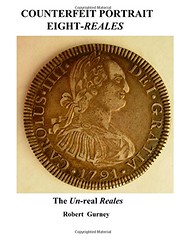 The book will now come in three parts:
The book will now come in three parts:
1. The Amazon Book B&W version for individuals that will not collect counterfeit 8 Reales or who do not care about good picture quality and just desire the information to determine counterfeit or regal on their pieces (Cost $40 approximately) for this 600 page book.
2. The Hardbound/Color Bibliophile/Collector's Edition to be offered in early/mid October. This hardbound edition will be showcased at the Mexican Numismatic Association (MNA) Convention. Cost estimates at this time is between $150-175 depending on Amazon book discounts. Orders will be taken at the Convention.
3. CDs will be able to be purchased from Swamperbob Associates P.O. Box 435 Hope Mills, North Carolina 28348 USA. The CDs will also be made available after the Mexican Numismatic Association (MNA) Convention but you can mail your request to Bob now at this North Carolina address.
4. The MNA and the Mexican Coin Company (MCC) will start to combine this above information in the MNA Journal and/or MCC website. Other numismatic publications will also advertise this information moving forward.
Bob Gurney adds:
I will still be taking orders for the Hardbound version at the USMexNA meeting in Scottsdale in October (pre-paid) but direct sales via other outlets will be available as well. Any sales made at the Convention will include the CDs. The CDs are still in production - I anticipate about a month delay in availability. Anyone can place an order for the CDs from myself. The price will be $20 for one set.
To read the earlier E-Sylum article, see:
NEW BOOK: COUNTERFEIT PORTRAIT EIGHT-REALES
(www.coinbooks.org/esylum_v17n37a08.html)

BOOK REVIEW: NEW JERSEY STATE COPPERS
 Colonial coin collectors tend to be a bookish bunch, not just by personality, but as collectors as well.
Colonial coin collectors tend to be a bookish bunch, not just by personality, but as collectors as well.
It will come as no great shock that the Numismatic Literary Guild “Book of the Year” award for 2014 has gone to a book about early American coins, the magnificent New Jersey State Coppers: History, Description, Collecting by Roger Siboni, John “Jack” Howes, and Buell Ish, co-published by the American Numismatic Society and the Colonial Coin Collectors Club.
The book is large, bound impressively and wrapped in a great-looking dust jacket. Its size (12.5 inches tall, 10 inches deep, more than 1.5 inches thick) is bigger than the standard for reference works nowadays, which may leave it as a shelf orphan, very much in the spirit of Dr. Edward Maris’ The Coins of New Jersey, whose “elephant folio” volume was more the size of a coffee table than a coffee table book.
The downside of such a production is its inevitable price. When a book retails for $235, it is almost guaranteed to be the numismatic equivalent of preaching to the choir. It’s tough to imagine someone with a casual interest in New Jerseys ever purchasing a book whose price could buy them a pretty nice New Jersey copper.
Further, the size makes the book not one to carry on a long plane ride or curl up with at the beach. Alas, with so much information, what else could have been done? Heavy editing would not have produced a better book, and multiple volume sets can be as unwieldy as a single large volume.
Beyond an extraordinary amount of information on the historical background of New Jersey coppers, their mints and the personalities involved in each, famous collectors in the series, and information on technology, each variety is studied in brilliant depth.
To read the complete article, see:
New book on New Jersey coppers should be required reading for all Colonial collectors
(www.coinworld.com/insights/Colonial-coin-collectors-enjoying-new-book-on-New-Jersey-coppers.html)
BOOK REVIEW: RAYMOND’S COINS OF THE WORLD
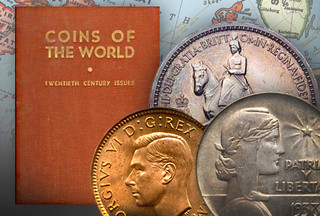 Raymond was a giant in the field since the early 1900’s. He conducted retail and auction sales, marketed the National line of coin albums invented by M.L. Beistle of Shippensburg, PA, and above all was famed for his many coin publications. Profoundly conservative, he opposed fads in American collecting and limited distribution of his books to what he called “established dealers.”
Raymond was a giant in the field since the early 1900’s. He conducted retail and auction sales, marketed the National line of coin albums invented by M.L. Beistle of Shippensburg, PA, and above all was famed for his many coin publications. Profoundly conservative, he opposed fads in American collecting and limited distribution of his books to what he called “established dealers.”
He demanded order in his world coin listings and exercised great care to include only coins struck for circulation by legitimate governments. Proofs were not listed separately and coins generally appeared in chronological order of issue. Coins of monarchies, such as British and British Empire, were broken down by ruler.
First issues of George V from 1911-1927 were distinct from second reverse coins 1927-1936, but the debased silver of 1921 onward was not listed separately. Metal order was Gold, Silver, Bronze, with newer alloys such as Copper-nickel or Nickel-brass appearing in their denominational position.
Raymond presented the highest denominations first, followed by the rest in descending order, in the British case Crown, Half Crown, Florin, Shilling, Sixpence, Threepence, Penny, Halfpenny, Farthing. Dates were presented in ranges, such as 1937-1948, which did not mean that all years in between were actually struck.
A single catalog price was given for the most common date of each type, in Uncirculated for most modern dates, “at least Very Fine” for older pieces. Remember, virtually no one collected world coins by date in the 1950’s, and Raymond paid little attention to Mint marks.
Coins were illustrated by halftones grouped on plate pages, (which caused havoc among fast-evolving Chinese listings) or dropped into the text. Photos illustrated basic types, and many coins photographed came from the ANS collection, such as the Somalia base silver one Somalo with its distinctive fingerprint on the reverse. Hard covers, high quality glossy stock and elegant typography made all editions of Coins of the World durable and attractive.
Raymond never asserted that his work was perfect. Exceedingly slow to make changes, he delayed correcting errors even when these were respectfully pointed out by experts such as Dr. Imre Molnar, who noted the anachronistic 1955 description of Hungary as “bounded on the west by Germany” as it had been in 1938-1945.
Pricing was a source of debate and new additions were seldom priced at all as Raymond believed time had to pass to allow the emergence of realistic pricing. World War II listings for countries like Slovakia included many errors such as metals that were never used, and these remained chaotic until the end. Nevertheless, Coins of the World really established the path for modern world collecting and was a gigantic step forward little appreciated today.
Wayte Raymond died on Sept. 23, 1956 and most of his publications ceased or were purchased by others. Veteran dealer John J. Ford Jr. wrote a five-page appreciation for the February 1957 issue of The Numismatist, “ Wayte Raymond: the Man and his Era” the only obituary ever to win the ANA’s highest literary award.
To read the complete article, see:
First Read: Wayte Raymond’s Coins of the World
(www.coinweek.com/featured-news/first-read-wayte-raymonds-coins-world/)
SELECTIONS FROM SKLOW LITERATURE SALE #23
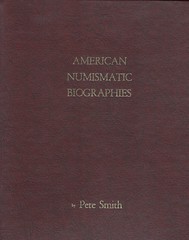
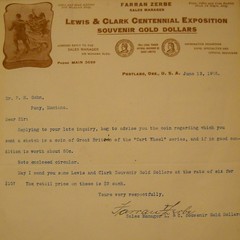
309. Smith, Pete. AMERICAN NUMISMATIC BIOGRAPHIES. HARD BOUND LIMITED NUMBERED EDITION NUMBER 13 OF 25. Rocky River, Ohio. 1992. 252pp. Printed on rectos only. 4to. Original half brown leather with red marbled boards, spine gilt, brown leatherette paste downs and endpapers. The Hard Bound Limited Numbered Edition, Number 13 of only 25 produced; bound in at front the limited edition sheet which reads – AMERICAN NUMISMATIC BIOGRAPHIES Limited Deluxe Edition Copy # 13 of 25 Copies, Distributed & Sold by: THE MONEY TREE, Dealers in Numismatic Literature, 1260 Smith Court, Rocky River, Ohio 44116; a scarce volume in the hardbound version, with only 25 copies produced; Very Fine. (300.00)
520. Zerbe, Farran. LETTER FROM FARRAN ZERBE TO MR. P.H. GOHN ON OFFICIAL LEWIS & CLARK CENTENNIAL EXPOSITION SOUVENIR GOLD DOLLARS LETTERHEAD. Portland, Ore. June 13, 1905. 8 .5 x 11 inch single sheet on official Lewis & Clark Centennial Exposition Letterhead, Farran Zerbe, Sales Manager. The letter reads - Mr. P.H. Gohn, Pony, Montana. Dear Sir: Replying to your late inquiry, beg to advise you the coin regarding which you sent a sketch is a coin of Great Britain of the "Cart Wheel" series, and if in good condition is worth about 50c. Note enclosed circular. May I send you some Lewis and Clark Souvenir Gold Dollars at the rate of six for $10? The retail price on these is $2 each. Yours very respectfully, [signed] Farran Zerbe, Sales Manager L. & C. Souvenir Gold Dollars; the letterhead is very ornate; the entire sheet is matted in a velvet matting with three cutouts, one 8 x8 to show the letter, and two 2 x 2 cutouts that I will assume were there to hold an obverse and reverse example of the Lewis & Clark Gold Dollars; the letter is defect free except for old creases from being folded for mailing; a very unique item; Fine. (250.00)
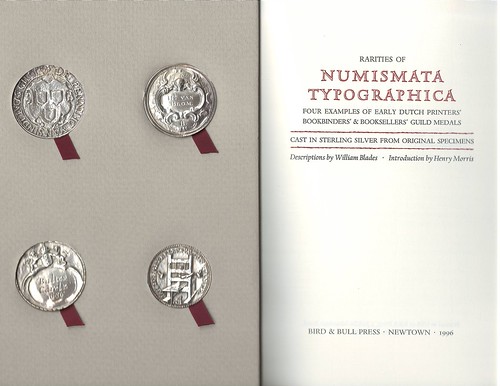
522. Blades, William {descriptions} and Morris, Henry. RARITIES OF NUMISMATA TYPOGRAPHICA: FOUR EXAMPLES OF EARLY DUTCH PRINTERS' BOOKBINDERS' & BOOKSELLERS' GUILD MEDALS: CAST IN STERLING SILVER FROM ORIGINAL SPECIMENS. Bird & Bull Press. Newtown. 1996. [1]-32pp. (4). 8vo. Original brown cloth covers, gilt lettering on leather spine label, housed in a matching slip case together with the thick folder containing four cast in sterling silver replicas of the guild medals. A magnificent work as every one of Henry Morris's efforts turn out; the descriptions throughout the this work have been taken from William Blades' Numismata Typographica, London, 1883... This is copy no. 28"; the medals are stunning reproductions; a scarce and most interesting work; Very Fine. (350.00)
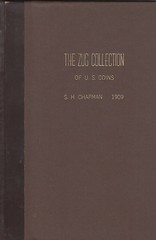

1165. Chapman, S.H. {Lippincott, Son & Co.}. CATALOG OF THE VALUABLE COLLECTION OF UNITED STATES GOLD AND SILVER COINS OF THE LATE CHARLES GORDON ZUG, ESQ., OF PITTSBURGH. Philadelphia. October 22, 1909. 34pp. 588 lots. 4 Fine Full Tone Photographic Plates. Hand priced neatly in red fountain ink. 8vo. Quarter brown calf with brown cloth covers, gilt. Original white paper front cover with gilt lettering bound in. Much has been written about Zug's collecting by S.H. Chapman in this catalog of the sale, and quoted in the few auction appearances of this rarity; Zug died very young [36 years old] but, amassed a formidable collection; there were no coppers in this sale as Chapman had sold them two years earlier; the sale boasted choice gold, gold proofs, 1886-S no motto half, two 1796 and one 1797 half dollar, small denomination private gold; One of only six examples known, and the first appearance at auction in ten years; ... Adams 5, B: Davis 217: Gengerke (5): Fine/Very Fine. (7500.00)
1166. Chapman, S.H. {Lippincott, Son & Co.}. CATALOG OF THE FINE COLLECTION OF THE GOLD, SILVER AND COPPER COINS OF THE UNITED STATES OF MAJOR RICHARD LAMBERT OF NEW ORLEANS. INCLUDING A SERIES OF ENGLISH CROWNS: TO WHICH IS ADDED THE WAR MEDALS OF THE JEWETT COLLECTION, INCLUDING THE RARE GEORGE III INDIAN MEDAL, AND A SMALL COLLECTION OF COINS. Philadelphia. October 21st and 22nd, 1910. (2), 58pp. 1019 lots. 6 Fine Full Tone Photographic Plates. Hand priced neatly in red fountain ink. 8vo. Original half white cloth, with white boards, gilt lettering. Original plated example; a beautiful collection of United States gold, silver and copper coins; the six plates depict these rarities, 1- Early Gold Eagles; 2- Quarter & Half Eagles; 3- Private and Territorial Gold; 4- Silver Dollars, Half Dollars, Quarters and Dimes [1794 Dollar, 1797 Half]; 5- Large Cents; 6- Colonial and British Silver; a very nice example; ... Adams 6, B: Davis 218: Gengerke (6): Fine. (1000.00)
David Sklow-Fine Numismatic Books
P.O. Box 6321
Colorado Springs, CO 80934
PH: 719-302-5686
FAX: 719-302-4933
Email: numismaticbooks@aol.com
Web Site: FineNumismaticBooks.com
THE JOURNAL OF NUMISMATIC RESEARCH
Journal of Numismatic Research (JNR) – Autumn 2012, Issue #1.
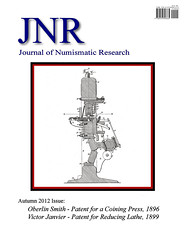 “OBERLIN SMITH – PATENT FOR A COINING PRESS, 1896.” United States patent number 574227 was issued to Oberlin Smith on December 29, 1896. Smith was owner of the Ferracute Company and had many years of experience in designing and manufacturing industrial and machine shop presses, lathes and other equipment. His company produced only two sizes of coin presses and sold a few to the U.S. Mint and others to foreign governments. This is the first publication of Smith’s complete patent text and illustrations.
“OBERLIN SMITH – PATENT FOR A COINING PRESS, 1896.” United States patent number 574227 was issued to Oberlin Smith on December 29, 1896. Smith was owner of the Ferracute Company and had many years of experience in designing and manufacturing industrial and machine shop presses, lathes and other equipment. His company produced only two sizes of coin presses and sold a few to the U.S. Mint and others to foreign governments. This is the first publication of Smith’s complete patent text and illustrations.
Price $10 retail..
“VICTOR JANVIER – PATENT FOR A MODEL REDUCING MACHINE, 1899.” (TRANSLATION BY MARGAUX C. THIEME-BURDETTE) Among American numismatists Victor Janvier is known almost entirely for the model reducing machine of his invention that was installed in the Philadelphia Mint in 1906. The French patent, number 294123, was issued on November 8, 1899 and amended in February 24, 1902. This is the first publication of his patent and includes all documents remaining in the French patent office archive.
Journal of Numismatic Research (JNR) – Spring 2013, Issue #2.
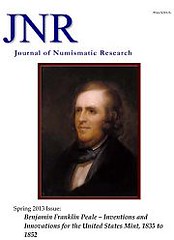 “BENJAMIN FRANKLIN PEALE – INVENTIONS AND IMPROVEMENTS FOR THE UNITED STATES MINT, 1835 TO 1852.” During Franklin Peale’s employment at the U.S. Mint from 1833 to 1854, he invented machinery and improved processes. These changes moved the mint from an outdated backwater, into the forefront of international coinage technology. This issue of JNR presents the first comprehensive review of Peale’s important contributions to the economic growth of the United States.
“BENJAMIN FRANKLIN PEALE – INVENTIONS AND IMPROVEMENTS FOR THE UNITED STATES MINT, 1835 TO 1852.” During Franklin Peale’s employment at the U.S. Mint from 1833 to 1854, he invented machinery and improved processes. These changes moved the mint from an outdated backwater, into the forefront of international coinage technology. This issue of JNR presents the first comprehensive review of Peale’s important contributions to the economic growth of the United States.
“IMPROVEMENTS IN THE METHOD OF MAKING WORKING DIES AND REDUCTIONS – 1835.” One of the goals of mint officials was uniformity of the coinage. Every piece of a certain denomination should be identical in weight, purity, size, shape and design to every other of the same denomination. To accomplish this, the mint went to considerable trouble to verify the all the blanks and planchets for coining were uniform. But when it came to actually making dies and striking coins from them, a multitude of factors intruded.
“IMPROVEMENTS IN ASSAYING AND PARTING SILVER, AND RECOVERING PRECIOUS METALS FROM WASTE WATER – 1835.” The two primary reasons for sending Franklin Peale to Europe in 1833 were to learn how to perform the “humid assay” of silver, and how to perform large scale parting of gold and silver using sulfuric acid. As with most tasks, Peale overcame reluctance by some of his European hosts and succeeded admirably in his assignment.
“INVENTION OF A TOGGLE-JOINT COINAGE PRESS – 1835.” The steam powered coining press designed by Franklin Peale is simultaneously his most recognized invention and the least well understood by coin collectors. This is understandable when one realizes that popular descriptions emphasized the use of steam power, rather than the singular technology of the press.
“IMPROVEMENTS IN ROLLING, DRAWING AND ANNEALING – 1835-1839.” Among lesser known mechanical improvements made by Franklin Peale were changes in the rolling mills, drawbenches and annealing furnaces. At present we have none of Peale’s drawings relating to these improvements and only incomplete descriptions of his work.
“INVENTION OF THE ECCENTRIC DRIVE BLANK CUTTING PRESS – 1836.” new presses were fast and required large quantities of blanks and planchets. To solve the problem of cutting blanks, Peale designed two somewhat different blank cutting presses for the U.S. Mints. A small version was introduced in 1836, and a second much larger type was designed and built between 1837 and 1851. Both designs dispensed with the obsolete screw press mechanism.
“INVENTION OF THE UPSETTING MACHINE – 1836.” While Franklin Peale was melter and refiner he invented and introduced the upsetting (or milling) machine, moved by steam power, for placing the raised edge on the rim of the coin. This machine was substituted for the imperfect and inefficient band machine, the only one previously known in the Mint. Such was the efficiency of the machine introduced by Peale that eight hundred (800) of the smaller denominations of coin per minute do not by any means limit its capacity.
“IMPROVEMENTS OF THE PILING BOX AND COIN COUNTING BOARD – 1837 AND 1839.” Counting boards and piling boxes might appear to be trivial innovations. Making piles of coins or blanks was a simple matter and counting was basic to most mint operations. Counting coins has been an important requirement of money-based economies since the first use of coinage. Stacking or piling coins is a more recent, though still very old practice. As a growing economy demanded larger quantities of coins, simple piece-by-piece counting failed.
“DESIGN FOR A STEAM ENGINE – 1839.” Peale’s 1839 horizontal steam engine was not the first used by the Philadelphia Mint, but it was the first to be fully designed and built with specific needs of the mint in mind. Power production was modest – just twenty-five horsepower – but the machine was quiet, reliable, and simple to operate by standards of the time.
“IMPROVEMENT OF BALANCES – 1835-1847.” Accurate analytical and bulk weighing balances were critical to the quality of American coinage. But when Peale visited the Paris Mint in 1833 he realized that the U.S. Mint was laboring with poor quality equipment. He acted quickly to relieve the situation and continued improving weighing equipment for the next fifteen years.
“IMPROVEMENTS IN ELECTROTYPING FROM MODELS OF METAL, WAX AND PLASTER – 1840.” The miracle of electricity was a primary subject of scientists and philosophical experimenters in the early nineteenth century. Working mostly as individuals, and collaborating through numerous letters and publications, electrical researchers rapidly gained a basic understanding of what electricity could do. Franklin Peale worked with a very simple electrotyping apparatus known as single cell deposition. This method did not require constructing a battery, but depended only on the small current developed within a container, to deposit copper onto a mold.
“HIRING OF WOMEN TO ADJUST PLANCHETS AND OPERATE PRESSES – 1850.” Men were employed to adjust planchets and operate presses until early 1850 when women were given a trial as adjusters by coiner Franklin Peale. His innovation was to turn a significant part of the coining process over entirely to female employees, and to do this within a major government bureau. His decision was evidently inspired by a combination of errors by the male adjusters, and the drive to save money.
“DESIGN FOR A STEEPLE ENGINE – 1851.” The last major design project by Franklin Peale was for a new vertical steam engine for the Philadelphia Mint. By this time the science of machinery had left the designer in the dust and his best effort was functionally obsolete before it was completed.
“OPINIONS AND COMMENTS ON COINAGE AND MINT OPERATIONS 1855, 1870.” Peale’s opinions about American coinage were remarkably consistent during his lifetime. Some found their way into the Coinage Act of 1873, others fell by the wayside, and still others have yet to be considered. This brief article presents his opinions and suggestions for present and future numismatists to contemplate.
Price $20 retail.
Journal of Numismatic Research (JNR) – Summer 2013, Issue #3.
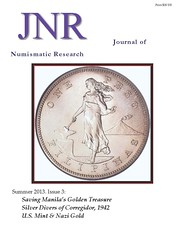 “SAVING PHILIPPINE GOLD AT THE BEGINNING OF WORLD WAR II: JANUARY TO MARCH 1942.”
Following the surprise attack on Manila on December 8, 1942, banks and individuals sought to get their valuables, including gold bullion from local mines, to safety. One American submarine was able to help by using the gold and silver as ballast.
“SAVING PHILIPPINE GOLD AT THE BEGINNING OF WORLD WAR II: JANUARY TO MARCH 1942.”
Following the surprise attack on Manila on December 8, 1942, banks and individuals sought to get their valuables, including gold bullion from local mines, to safety. One American submarine was able to help by using the gold and silver as ballast.
“SILVER DIVERS OF CORREGIDOR, WORLD WAR II: MAY TO NOVEMBER 1942.” Just before the Philippine island of Corregidor fell to the Japanese, large quantities of silver coins were dumped in in Manila Bay. It was hoped that the coins could thus be hidden from the invaders. Within days, the silver coins were located and American prisoners conscripted to bring the valuables to the surface.
“U.S. MINT & NAZI GOLD, MERKERS KAISERODA SALT MINE TREASURE, WORLD WAR II: JUNE TO AUGUST 1945.” Under orders from Nazi leadership, primarily Hermann Goering and Heinrich Himmler, conquered people and nations were systematically stripped of art, gold and other valuables. Recovery of the treasure after the end of the European war had an unexpected connection to the U.S. Mint. Issue price $20 retail.
Journal of Numismatic Research (JNR) – Autumn 2013, Issue #4.
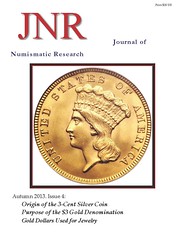 “ORIGIN OF THE 3-CENT SILVER COIN.”
Beneath the angry public debates on slavery, new state admissions and regional commerce, two important topics permeated the country. One was the need for a consistent national currency of gold and silver coins that was uniformly available and of equal value everywhere. The other was revision of the postal service so it could cheaply and securely ensure written communication across a vast, largely unpopulated continental nation.
“ORIGIN OF THE 3-CENT SILVER COIN.”
Beneath the angry public debates on slavery, new state admissions and regional commerce, two important topics permeated the country. One was the need for a consistent national currency of gold and silver coins that was uniformly available and of equal value everywhere. The other was revision of the postal service so it could cheaply and securely ensure written communication across a vast, largely unpopulated continental nation.
“JAMES B. LONGACRE AS A DIE ENGRAVER” A reassessment of the artistic and engraving talent of the Engraver fo the United States Mint.
“PURPOSE OF THE $3 GOLD COIN” Coin collectors have long wondered why Congress approved introduction of a $3.00 gold coin in 1854. Numerous speculations have been put forward, but none identified the initial motivation for this odd, seemingly useless denomination.
“GOLD DOLLARS USED FOR JEWELRY” Necklaces, bracelets, cufflinks, rings, pendants and a multitude of other items of personal adornment became the final resting places of thousands of tiny gold dollars. Coin collectors were the only refuge for these forgotten gold pieces.
Issue Price $20 retail.
Journal of Numismatic Research (JNR) – Winter 2014, Issue #5.
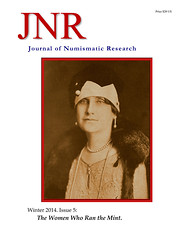 THE WOMEN WHO RAN THE MINT
The United States Mint was one of the first Federal government departments to hire women as full time employees. It was also among the forefront in promoting women to positions of managerial responsibility, and having them testify before Congress as civil service professionals. This article presents the stories of three outstanding women who helped open the doors to equal employment opportunity.
THE WOMEN WHO RAN THE MINT
The United States Mint was one of the first Federal government departments to hire women as full time employees. It was also among the forefront in promoting women to positions of managerial responsibility, and having them testify before Congress as civil service professionals. This article presents the stories of three outstanding women who helped open the doors to equal employment opportunity.
“MARGARET ELLEN KELLY – Acting Director of the Mint” “MARY MARGARET O’REILLY – Assistant Director of the Mint” “NELLIE TAYLOE ROSS – Director of the Mint”
Issue Price $20, retail.
For more information, or to order, see Wizard Coin Supply:
JOURNAL OF NUMISMATIC RESEARCH
(www.wizardcoinsupply.com/journal-of-numismatic-research/)
To read the earlier E-Sylum articles, see:
NEW PERIODICAL: JOURNAL OF NUMISMATIC RESEARCH
(www.coinbooks.org/esylum_v15n44a02.html)
REVIEW: JOURNAL OF NUMISMATIC RESEARCH, SPRING 2013
(www.coinbooks.org/esylum_v16n52a06.html)
REVIEW: JOURNAL OF NUMISMATIC RESEARCH 3-5
(www.coinbooks.org/esylum_v17n16a06.html)
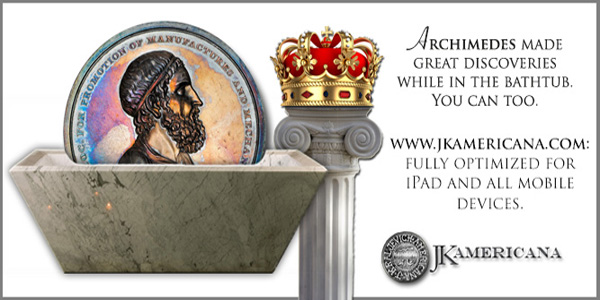
THE RED BOOK KNOCKOFF PUBLISHING DATE
Regarding one of the images from the counterfeit Red Book, Ken Spindler writes:
I'm pretty sure you have the image of the Chinese page of the copied book from Taiwan upside-down.
Ken Berger writes:
You definitely have the Chinese page upside down. How do I know? Well, besides being able to recognize Chinese characters, I can also recognize western-style numbers. Note the 56. Taiwan dating starts with 1911 (the first year of the Republic). The 56 refers to the year, which is 1911 + 56 = 1967.
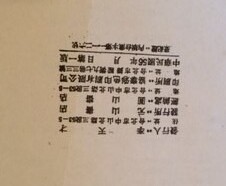
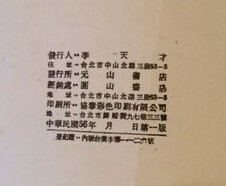
Original and corrected images
Dennis Tucker of Whitman Publishing writes:
We informed the eBay seller that he was infringing Whitman’s copyright and violating our trademark registration, and he removed the listing. Naturally we take this kind of thing very seriously --- a lot of time, energy, and work goes into developing a book’s intellectual property and maintaining its value.
To read the earlier E-Sylum article, see:
MORE ON THE RED BOOK KNOCKOFF
(www.coinbooks.org/esylum_v17n38a07.html)
NOTES FROM E-SYLUM READERS: SEPTEMBER 21, 2014
Monnaie de Paris Seals and Jetons Catalog Hedley Betts writes:
I have been following the discussion about the Catalogue General Illustre des Editiones de la Monnaie de Paris. There seems to be some confusion about the number of volumes in the complete set. In addition to the volumes noted by Paul Bosco, Dick Johnson and Scott Miller, there are at least two others: A fourth (and very large) section of volume 4, which adds to the entries in parts 1-3 and a volume six, which lists seals and jetons.
To read the earlier E-Sylum articles, see:
MONNAIE DE PARIS COMMEMORATIVE MEDAL CATALOGS
(www.coinbooks.org/esylum_v17n37a22.html)
MORE ON THE MONNAIE DE PARIS MEDAL CATALOGS
(www.coinbooks.org/esylum_v17n38a11.html)
Flynn Liberty Seated Half Dimes Book Update Author Kevin Flynn ( kevinjflynn88@yahoo.com ) submitted this update on his planned book on Half Dimes. He writes:
I am planning to go to print with the book The Authoritative Reference on Liberty Seated Half Dimes in two weeks.
My page count has gone up from what was planned to 275 pages, but sections such as the 1838 Small Stars required 17 pages, with detail diagnostics and photo showing each of the five die stages for the obverse and 4 die stages for the reverse.
With the extra pages, it will increase my cost, especially with a limited printing.
As such, once the book is printed, the cost of the book will increase to $49.95, up to when this book is printed, I will accept the originally advertised price of $39.95
To read the earlier E-Sylum article, see:
NEW BOOK: AUTHORITATIVE REFERENCE ON LIBERTY SEATED HALF DIMES
(www.coinbooks.org/esylum_v17n29a06.html)
More on Eccentric Bimetallic Coins
 Serge Pelletier writes:
Serge Pelletier writes:
I'm sad to say that my esteemed colleague Michael Alexander's statement that the recently issued Portuguese coin is "the world's first eccentric (not placed centrally) bimetallic coin" is incorrect. Canada issued coins that can meet that description back in the 1980s-1990s... A series of 20-dollar coins on aviation that had a gold cameo off centre.
To read the earlier E-Sylum article, see:
WORLD'S FIRST ECCENTRIC BIMETALLIC COIN
(www.coinbooks.org/esylum_v17n38a29.html)
Giving Away Unwanted Coin Catalogs Martin Kaplan writes:
Instead of recycling my unwanted catalogs, I took them to a local show. The show organizers let me put them on a table in the registration area. I was amazed at how quickly they disappeared! So now I have a box in the trunk of my car into which I toss unwanted catalogs for the next show. I guess I didn't appreciate how one man's trash is another man's treasure. Most catalogs are educational. If more of us did this, think how many additional people would be exposed to a part of the hobby they weren't aware of?
Thoughts on "Early Strikes" Ron Pope writes:
The term "early strike" makes some sense if it's used in the proper context, that being one of the first thousand or two coins struck by a particular die or, in other words, a coin that would be classified as very early die state. Unfortunately, I have a feeling that's not the true meaning of the used terms at all. "First strike" makes no sense at all IMO-just another attempt to separate the collector from his money I think.
To read the earlier E-Sylum article, see:
PHILIP DIEHL ON FIRST STRIKE COINAGE
(www.coinbooks.org/esylum_v17n38a18.html)
Who Were the Real Forgers? Regarding this statement in last week's item about coin forgers ("I compare the work of the legendary coin forgers Giovanni Cavino, Carl Becker and Constantine Christodoulos to that of a modern forger of Celtic coins."), Roger Burdette writes:
If the forgers were legends, then who were the real forgers?
To read the earlier E-Sylum article, see:
HASLEMERE AND THE LEGENDARY ANCIENT COIN FORGERS
(www.coinbooks.org/esylum_v17n38a28.html)
The Taco Bell Silver Dollar Justin Perrault writes:
This is a funny commercial I recently saw advertising the Taco Bell Dollar Menu, featuring the reverse of an old Morgan Dollar. Some of the comments in the thread below it are just as interesting as the video itself.
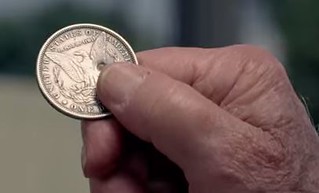
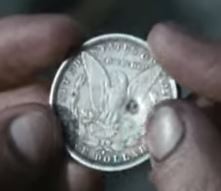 Funny video - be sure to watch it. So what is that mark/indentation/counterstamp on the coin's reverse? Where did they GET this piece? I wonder if it belongs to someone on the set of the commercial, or if they picked one out of a dealer's junk silver box. Interesting.
-Editor
Funny video - be sure to watch it. So what is that mark/indentation/counterstamp on the coin's reverse? Where did they GET this piece? I wonder if it belongs to someone on the set of the commercial, or if they picked one out of a dealer's junk silver box. Interesting.
-Editor
To view the video, see:
Silver Dollar | 2014 Taco Bell® Dollar Cravings Menu™ Commercial
(www.youtube.com/watch?v=nzJo7QMMfTQ)
ATTRIBUTING 1861-O HALF DOLLAR VARIETIES

My thanks to Howard for posting the source of the “ran out of bullion” comment in his excellent article on visiting the New Orleans Mint (V17, #35). I’ll stand by my earlier comments in last week’s E-Sylum (in re “ran out of bullion”) and merely note that the museum’s card is an example of inadvertently perpetuating a popular misconception – after all, it seems to makes sense, doesn’t it?
Interestingly, the text on the card image Howard posted calls for additional comments. First is toward the bottom – “….most of the coins minted at this time were not struck with a proof-like finish…” (referring to the coin on exhibit). Absolutely true! Just for clarification, however, branch mint proofs are known from several facilities, including New Orleans. They are extremely rare and were struck in minute quantities when some event worth commemorating occurred. The five or six known 1861-O half dollar proofs were authenticated by Walter Breen as having been struck to commemorate the Confederacy accepting control of the New Orleans Mint from Louisiana and were thus struck under Confederate authority.
The second is at the top – “This coin might have been minted by any one of three Governments that controlled the New Orleans Mint facility in the first half of 1861” (see previous sentence). While this also refers specifically to the coin on exhibit, it suggests what we have all been told for years - that the United States, Louisiana and the Confederacy all struck 1861 half dollars at New Orleans and all were struck using US dies so we can’t tell which authority struck any given coin, right?
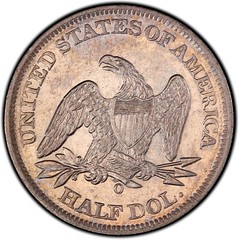 Well, thanks to the landmark work of Randall Wiley and Bill Bugert this is no longer the case. They performed lengthy studies of 1861-O half dollar die marriages (a coin struck using one obverse die and one reverse die, in effect “marrying” those two dies in the resulting coin). Ultimately 14 die marriages were identified - the CSA Half Dollar was not included since the US die it employed was already accounted for. These findings, along with examples, were detailed in Randall Wiley’s Die Marriages of 1861-O Half Dollars in the Gobrecht Journal (Vol 32, No 94; Nov, 2005); and in Bill Bugert’s Liberty Seated Half Dollar Die Varieties, Volume IV (see E-Sylum Volume 16, Number 49, Dec 1, 2013).
Well, thanks to the landmark work of Randall Wiley and Bill Bugert this is no longer the case. They performed lengthy studies of 1861-O half dollar die marriages (a coin struck using one obverse die and one reverse die, in effect “marrying” those two dies in the resulting coin). Ultimately 14 die marriages were identified - the CSA Half Dollar was not included since the US die it employed was already accounted for. These findings, along with examples, were detailed in Randall Wiley’s Die Marriages of 1861-O Half Dollars in the Gobrecht Journal (Vol 32, No 94; Nov, 2005); and in Bill Bugert’s Liberty Seated Half Dollar Die Varieties, Volume IV (see E-Sylum Volume 16, Number 49, Dec 1, 2013).
The point is that we are now able to distinguish between the three minting authorities and properly attribute 1861-O Half Dollars! I imagine the "can’t tell which authority struck any given coin" tradition will probably remain with us for a while though.
To read the earlier E-Sylum articles, see:
MORE ON CONFEDERATE MINTING IN NEW ORLEANS
(www.coinbooks.org/esylum_v17n38a14.html)
NEW BOOK: LIBERTY SEATED HALF DOLLAR DIE VARIETIES, VOLUME IV
(www.coinbooks.org/esylum_v16n49a03.html)
THE BOOK BAZARRE
CONFEDERATE CURRENCY PRINTERS LEGGETT, KEATINGE & BALL
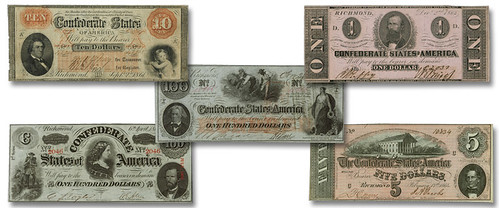
During the American Civil War, the Confederate States of America issued their own circulating paper money for use in daily commerce. Notes were produced in various types from 1861 to 1864. Due to the challenges of unstable supply lines, lack of reliability, military encroachment and other factors, the Confederate government employed numerous different firms for the production of Confederate treasury notes. Certainly the most prodigious producer of these notes was the firm of Leggett, Keatinge & Ball.
In August of 1861 Edward Keatinge, an Englishman who worked as an engraver for the American Bank Note Company, relocated to Richmond, Virginia upon receiving an offer from the Confederate government to establish a printing firm. Keatinge partnered with Thomas Ball, a lawyer, who was invited by Confederate Treasury Secretary C.G. Memminger to join in the founding of the firm. Keatinge and Ball were joined in September 1861 by William Leggett (also formerly an employee of the American Bank Note Company) who specialized in lettering.
With the firm ready to begin operations in Richmond, their first order of business was to produce desperately needed $5 and $10 bills. Quickly they altered a steel plate originally used on $5 notes for the Mechanics Savings Bank of Savannah, Georgia, removing the bank title and adding the required Confederate clauses and banner. The resulting product is now known as Confederate Type 32, a scarce 1861 dated $5 note. At the same time they produced a newly designed $10, now known as Type 24. Type 32 carried the printer's imprint of Leggett, Keatinge & Ball Richmond, VA as did Type 24 for a while. In March 1862 Leggett was forced out of the company after Secretary Memminger's accusation that Leggett had been associated with a Union spy. Keatinge & Ball continued with the company, removing Leggett's name.
Among possessions found in assassinated president Abraham Lincoln's possessions on April 15, 1864, was a Type 69 Series of 1864 $5 Confederate treasury note produced by Keatinge & Ball.
To read the complete article, see:
A Brief History of Confederate Currency Printers Leggett, Keatinge & Ball
(www.stacksbowers.com/NewsMedia/Blogs/TabId/780/ArtMID
/2678/ArticleID/64741/A-Brief-History-of-Confederate-Currency
-Printers-Leggett-Keatinge--Ball-.aspx)
CHRISTMAS TREE COIN HOLDER HOARD FOUND
One of the great rarities cataloged and illustrated in my book on National Coin Albums is the coin Christmas Tree published by The Beistle Company, manufacturer of all Wayte Raymond coin albums and holders. This was issued for Christmas 1957 on the 30th anniversary of M. L. Beistle’s Unique Coin Holder, the precursor of what became The National Coin Album.
When preparing my book I’d seen only the worn example in my own collection, which I purchased with the original coins still in place, and one other held by a fellow collector. Recently, however, I was able to purchase a small hoard of unused examples in Near Mint condition. These, of course, are coinless, but I’m able to offer them through this newsletter while they last at the bargain price of $25 postpaid. Please see the photos accompanying this newsletter.
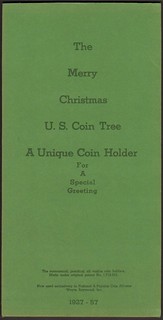
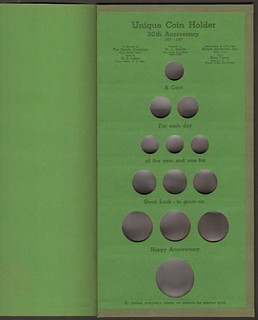
David W. Lange
POB 110022
Lakewood Ranch, FL 34211
941-586-8670
coincollectingboards.com
To read the earlier E-Sylum articles, see:
RAYMOND-BEISTLE CHRISTMAS TREE COIN HOLDER
(www.coinbooks.org/esylum_v14n53a21.html)
MORE ON THE RAYMOND-BEISTLE CHRISTMAS TREE COIN HOLDER
(www.coinbooks.org/esylum_v15n01a13.html)

COINWEEK INTERVIEWS MIKE CASTLE
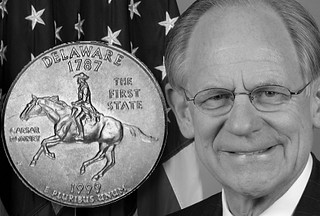 Congressman Mike Castle served as governor of the state of Delaware from 1985 to 1992 and served almost eighteen years (1993-2011) as a member of the United States House of Representatives from Delaware’s at-large district*. While in Congress, Castle was the head of the United States House Financial Services Subcommittee on Domestic Monetary Policy and Technology, a subcommittee of the House Committee on Financial Services. While serving in this capacity, Castle sponsored legislation that authorized production of the 50 State Quarters program–the largest circulating commemorative coin program in American history. He also had jurisdiction over issues concerning coins, medals, and currency.
Congressman Mike Castle served as governor of the state of Delaware from 1985 to 1992 and served almost eighteen years (1993-2011) as a member of the United States House of Representatives from Delaware’s at-large district*. While in Congress, Castle was the head of the United States House Financial Services Subcommittee on Domestic Monetary Policy and Technology, a subcommittee of the House Committee on Financial Services. While serving in this capacity, Castle sponsored legislation that authorized production of the 50 State Quarters program–the largest circulating commemorative coin program in American history. He also had jurisdiction over issues concerning coins, medals, and currency.
CM: So Congressman, in numismatic circles you’re known for your role in sponsoring and pushing through Congress legislation that authorized the creation of the 50 State Quarters® Program. How did that come about?
MC: Well first, I did not have a personal history of coin collecting and the reason that the coin collecting community approached me was because I was named head of the subcommittee of the Financial Services Committee that had oversight of the U.S. Mint. So, the collecting community approached my staff and me and made their pitch to change the quarter in order to celebrate the history of the 50 states.
CM: What did you think of their proposal?
MC: My initial reaction was one of strong uncertainty. I wasn’t really sympathetic to changing our currency. I didn’t want it to turn into Monopoly® money, so I needed to be sold on it and they preceded to do that.
CM: What convinced you?
MC: Well, the collectors came back to me and they indicated that the American public would have great interest in the program. They proposed the idea that the quarters would be released in the order the states were admitted into the Union. Of course, I liked that because I was from Delaware and Delaware was the first state.
CM: Obviously, you had to convince a lot of people that this bill was a good idea…
MC: Yes. Well, I had to convince Treasury Secretary Robert Rubin and Deputy Secretary Larry Summers that it was a good idea. They were skeptical themselves and asked for a study, which Coopers & Lybrand did. In their report, Coopers & Lybrand said that everything represented in the coinage proposal was accurate. It was something that could make money and would have a broad appeal for the American people. For that reason, they basically recommended it.
CM: How did you get the bill through the House and Senate. People, I think, are interested in knowing how the sausage gets made, so to speak.
MC: My staff and I had to work other people on the subcommittee and the Financial Services Committee. We had to convince leadership that it was worthwhile, otherwise they wouldn’t have considered it. In time, we were able to do that. For me, the more difficult task was trying to convince the Senate. I didn’t have immediate connections over there, but eventually both houses of Congress thought it was a good idea.
CM: Seems like once there was momentum behind the legislation, it would have been an easy vote.
MC: Yes, it was an easy vote.
CM: Obviously, the Delaware State Quarter was the first one struck. Did you attend the launch ceremony?
MC: Yes, I did. And that’s when I realized the excitement of it. The launch ceremony was held at Caesar Rodney Square; Caesar Rodney, one of the great patriots of the Revolution, a signer of the Declaration of Independence. The Wilmington Trust Company distributed the quarters. There was a big turnout and lots of enthusiasm. After that, I started to hear from a lot of other people, other members of Congress, that it was good for them and that they were excited about it.
To read the complete article, see:
CoinWeek Q&A with Former Congressman Mike Castle
(www.coinweek.com/featured-news/coinweek-qa-former-congressman-mike-castle/)
LONG-MISSING INVERTED JENNIES SOUGHT
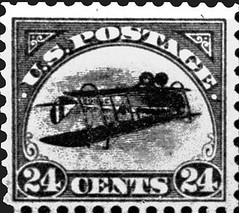 Working swiftly and silently, someone cut the rope securing the leg of the display case and inched it forward. A sheet of protective glass was slid back, and four rare stamps were plucked from their display frame.
Working swiftly and silently, someone cut the rope securing the leg of the display case and inched it forward. A sheet of protective glass was slid back, and four rare stamps were plucked from their display frame.
Minutes later — around 9:30 on a September morning in 1955 — a delegation of esteemed philatelists strolled down the row of display cases, looking expectantly for the star item of the collection: a block of four famous 24-cent stamps with the airplane in the center printed upside down in error. The stamp is known to collectors as the Inverted Jenny, after the nickname of the Curtiss JN-4 biplane.
But the block was gone. The Federal Bureau of Investigation interviewed the armed guards and others in the room and came up empty, unable to even name a suspect.
In the nearly 60 years since that theft, two of the stamps have been recovered, but the other two remain lost. Now, a prominent stamp dealer is offering a $100,000 reward to try to help close the case.
Donald Sundman, the president of the Mystic Stamp Company, a mail-order firm in Camden, N.Y., announced Saturday at an annual gathering of airmail stamp collectors that he was putting up $50,000 for each of the two missing Inverted Jennies.
The stolen block belonged to Ethel B. Stewart McCoy, one of the most prominent philatelists of her day. Ms. McCoy was a New Yorker and the daughter of Charles Milford Bergstresser, a journalist who with Charles Dow and Edward Jones was a founder of Dow Jones & Company. Her inherited wealth allowed her to happily indulge her collecting passions, which included airmail stamps of the world and stamps depicting palm trees, of which she had three albums full.
Her Inverted Jenny block was one of just a half-dozen surviving intact from the original sheet of 100 misprints, bought over a post office counter in 1918 by a lucky broker’s clerk who quickly resold them to a prominent collector. That collector dispersed the sheet, mostly as single stamps, after numbering each one on the back in pencil.
Ms. McCoy’s foursome had been a gift in 1936 from her first husband, so its sentimental value to her greatly exceeded the $15,000 she insured it for before lending it to the American Philatelic Society to exhibit at its Norfolk, Va., convention in the fall of 1955.
What happened afterward is described in detail by George Amick in his 1986 book, “The Inverted Jenny: Money, Mystery, Mania.”
To read the complete article, see:
$100,000 Reward for Missing ‘Jennies’
(www.nytimes.com/2014/09/15/us/100000-reward-for-missing-inverted-jennies-stamps.html)
ODYSSEY MARINE SUSPENDS SS CENTRAL AMERICA OPERATIONS
A deep-sea salvage vessel that's been pulling up gold and other treasure from a shipwreck off South Carolina has returned to Charleston and likely won't resume work at the site until next year.
Florida-based Odyssey Marine Exploration Inc. said Tuesday that its Odyssey Explorer is back in port for a few weeks for repairs and to be upfitted with new equipment.
The company said it ended its first recovery phase after retrieving more than 15,500 gold and silver coins, 45 gold bars and hundreds of nuggets, jewelry and other artifacts from the SS Central America. The value of the items was not disclosed.
Odyssey Explorer left Charleston in April. The wreck of the SS Central America is in 7,200 feet of water about 200 miles off the coast, Odyssey Marine said.
Recovery efforts were hampered in recent weeks by Hurricane Cristobal and by the time required to complete a high-resolution video survey of the wreck and surrounding area, the company said.
Odyssey Marine said "an extensive amount of knowledge has been gained" about the site and the scope of the work required.
"Significant sections of the ship's structure, associated cultural heritage artifacts and coins were located some distance from the main shipwreck area, requiring excavation over a large area," the company said Tuesday. "Sizable areas remain to be inspected and excavated outside the main shipwreck."
Gordon said the next step is to study the data collected over the past five months.
To read the complete article, see:
Shipwreck recovery off South Carolina coast is suspended
(www.postandcourier.com/article/20140916/PC05/140919581/1177/shipwreck-recovery-off-south-carolina-coast-wraps-up-for-now)
THE BOOK BAZARRE
JOHN QUINCY ADAMS TWEETS FROM BEYOND THE GRAVE
Anne E. Bentley, Curator of Art & Artifacts, Massachusetts Historical Society writes:
We have been tweeting John Quincy Adams’s diary since the 200th anniversary of his first entry in November 1779-his last entry was shortly before his death in 1848. We’re up to 1814 now, and this time 200 years ago he mentioned a couple of medal collections.
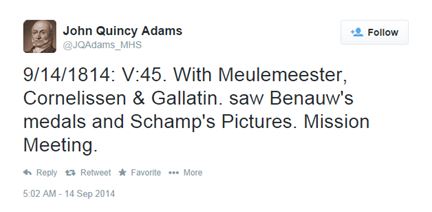
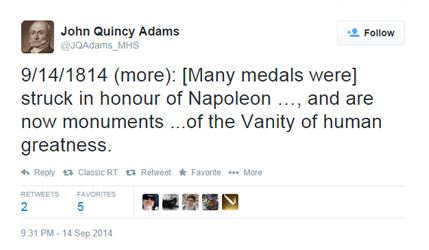
Here's a clue. Anne adds:
Adams had been in St Petersburg as our first ambassador to Russia. But by this date he had left Russia and was in Paris negotiating the Treaty of Ghent to end the War of 1812.
For more information on the John Quincy Adams Papers, see:
John Quincy Adams Papers (1767 - 1848)
(millercenter.org/president/jqadams/papers)
To read the complete Adams diary, see:
The Diaries of John Quincy Adams
(www.masshist.org/jqadiaries/php/)
MORE ON VAIL MEDAL RECIPIENT JOSEPHINE AUGUST
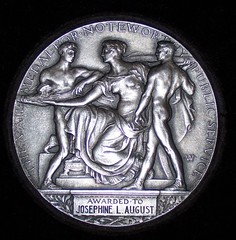 Regarding the Vail medal Jon Radel wrote about recently, web site visitor Shauna Willoughby of
Alberta, Canada writes:
Regarding the Vail medal Jon Radel wrote about recently, web site visitor Shauna Willoughby of
Alberta, Canada writes:
I have a copy of the book – “For Noteworthy Public Service” dated 1950. Attached is a scan of the story found within its pages on Mrs Josephine L August. There’s also a beautifully embossed image of the Vail Medal – both sides - with a description of the medal as well.
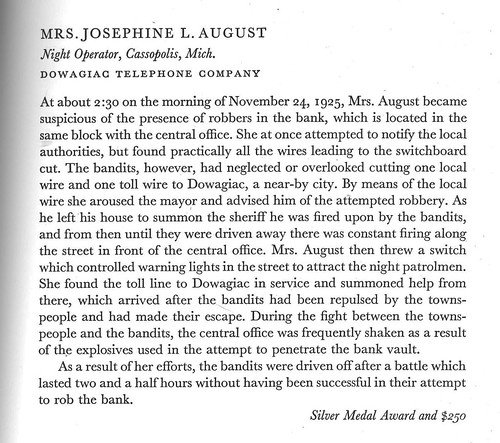
To read the earlier E-Sylum articles, see:
1925 THEODORE N. VAIL MEMORIAL MEDAL
(www.coinbooks.org/esylum_v17n25a10.html)
THEODORE N. VAIL NATIONAL AWARD MEDALS
(www.coinbooks.org/esylum_v17n26a13.html)
SOME INTERESTING MEDALS: SEPTEMBER 21, 2014
George Robinson Lifesaving Medal
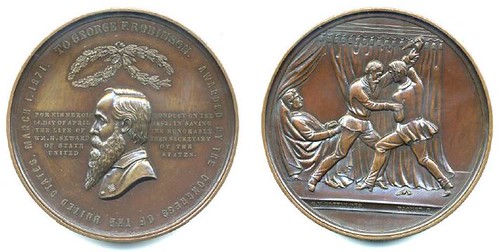
GEORGE F. ROBINSON. PE-27. 77mm. Copper, bronzed. Anthony Paquet, Sc. (U.S. Mint) Choice About Uncirculated. Obverse with a bearded bust of Robinson to the left with a legend honoring him for his heroic conduct on April 14, 1865 in saving the life of Secretary of State William Seward. The reverse depicts Robinson warding off the knife-wielding Lewis Paine, in his attempt to assassinate the bedridden Seward.
The reverse is one of the most dramatic of all medals in the U.S. Mint series. As Cornelius Vermule noted, “The reverse, sketched by G.Y. Coffin, presents the scene in the sickroom in the same theatrical terms that Harper’s and the Illustrated London News showed John Wilkes Booth’s attack on the President.” One of only 84 medals struck in copper.
New York Air Brake Medal

THE NEW YORK AIR BRAKE COMPANY 50TH ANNIVERSARY, 1940. 76.3mm. Bronze. Julio Kilenyi, Sc. Robbins Co.) Choice About Uncirculated with some light tarnish. Obverse: NEW YORK AIR BREAKS OF THE PRESENT above scene of a train speeding around a bend. Two line inscription on a raised band: THE NEW YORK AIR BRAKE COMPANY/ 1890 FIFTIETH ANNIVERSARY 1940. Below: Horse-drawn coach with 4 horses/ BRAKES OF THE PAST. Reverse: GOLDEN JUBILEE above depiction of air brakes. Below: AIR BRAKES BRING/ SURETY AND SWIFTNESS. A particularly nice industrial medal by the prolific Kilenyi.
Next are some medals I noticed on the site of one of our new advertisers, Hedley Betts. -Editor
René Baudichon Art Award Medal

Undated (circa 1900), France. ART AWARD. By René Baudichon. Silver 50mm. OBV: An allegorical female standing behind an artist seated at an easel. REV: A wreath, palette and implements
For more information, or to order, see: Baudichon: ART AWARD (www.mcssl.com/store/8596432/baudichon-art-award)
Georges Contaux Long Jump Medal
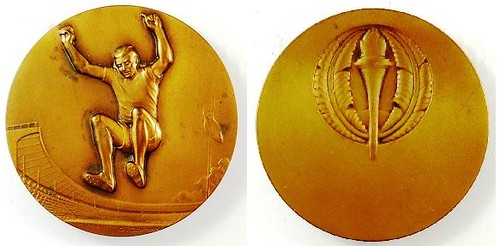
Undated (crca 1930), France. LONG JUMP. By Georges Contaux. AE 50mm. OBV: A man in mid jump, a stadium in the background. REV: A flaming torch. Some slight discoloration, nearly extremely fine.
For more information, or to order, see: Sports: LONG JUMP (www.mcssl.com/store/8596432/sports-long-jump)
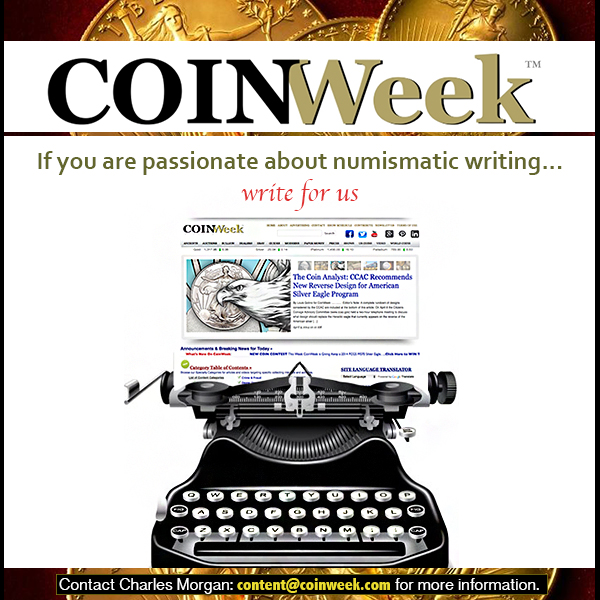
OCR AND NON-LINEAR LEGEND ORIENTATIONS
Rich Hartzog writes:
Dr. Greg Brunk, author of several books on counterstamped coins, brought up an interesting question. Are there any OCR programs that will transcribe inscriptions from struck tokens or medals? While I suspect there might be a program that does text in lines, exonumia generally has text both around the edge and in lines. I suspect that would be confusing for OCR programs. Does anyone have any experience with OCR on exonumia?
As an example of the complexity of the problem, consider the question from two weeks ago about the different ways text can be oriented on coins. With this much variation, this problem will be a tough nut to crack. -Editor
Bruce Smith had asked:
When a coin or medal has an inscription running in the border or near the edge of the flan, the bottoms of all the letters may point inward, OR they may point outward, OR the top inscription may have the letters pointing inward and the bottom inscription will have the letters pointing outward. Is there a term for these different orientations?

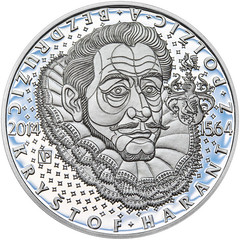
Inner- (left) and Outer-orientation (right)
To read the earlier E-Sylum article, see:
QUERY: INSCRIPTION ORIENTATIONS
(www.coinbooks.org/esylum_v17n37a21.html)
QUIZ: WHO HAD ALL VARIETIES OF 1793 CENTS?
Jim Neiswinter writes:
I posed this question in the last issue of Penny-Wise and no one got it, so I'd like to see if E-Sylum readers can do it.
Who was the only person ever to complete a collection (100%) of all the varieties of 1793 cents?
Jim adds:
I can also announce, thanks to Melanie Nathan who I met at the ANA convention, there is now a website for my book on the 1793 Sheldon 15 cent, The Aristocrat for anyone who would like to order a copy of the book.
For more information, or to order a copy, see:
http://nathan334.wix.com/the-aristocrat

Archives International Auctions, Part XX
Hong Kong 3
Chinese & Asian banknotes, scripophily & coins. Included will be over 270 lots of rare and desirable banknotes.
No earlier than 6PM local time
Highlights include:
- Lot 1847: Netherlands Trading Society $5
- Lot 1942: Hong Kong & Shanghai Banking Association 1913 $1 Specimen Banknote
- Lot 1947: Hong Kong, Mercantile Bank of India 1941 Issue

1580 Lemoine Avenue, Suite #7
Fort Lee, NJ 07024
Phone: 201-944-4800
Email: info@archivesinternational.com
WWW.ARCHIVESINTERNATIONAL.COM
THE LIFE AND WORK OF CHESTER BEACH
Chester Beach was born on May 23, 1881 in San Francisco, CA. Relatively little is known about his early life, but at a young age he must have acquired an interest in art as he enrolled in the California School of Mechanical Arts when he was eighteen years old. He did not stay there for any length of time, however, as he soon enrolled in the Mark Hopkins Institute of Art, specializing in Jewelry design. Like many young American artists at the turn of the century, he moved to Paris, studying at the Ècole des Beaux Arts, before returning to the United States and opening a studio in New York City upon his return in 1907. He would remain in that city for the rest of his life, first working on 10th street and later relocating to 17th street.
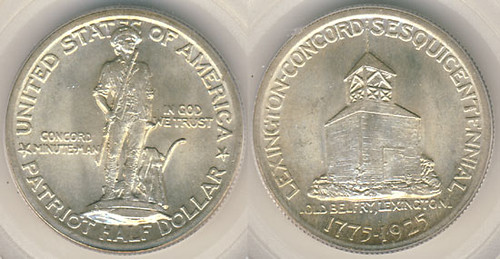
In the art world, Chester Beach is mostly known for his busts as well as medals, and in the numismatic world of course for the four commemorative coins he designed or helped design. These are the 1923-S Monroe Half Dollar, the 1925 Lexington-Concord Half Dollar, the 1928 Hawaiian Half Dollar (modeled after designs by Juliette May Fraser) and the 1935 Hudson Half Dollar. Two of these (the Hawaiian and the Hudson) are considered to be key-dates within the classic commemorative series and are highly prized by collectors, and the Lexington-Concord is a popular issue with collectors because of its historical subject matter.
One of the medals designed by Chester Beach is definitely worth a closer look. This is the 1919 medal issued by the American Numismatic Society commemorating the Peace of Versailles, one of the treaties that ended World War I. A scarce medal, a total of 318 bronze and 113 silver medals were made, each individually numbered on the rim. Beach’s design featured semi-nude figures representing War and Victory walking along with Justice seated on a winged Pegasus. A female represents victory while both War as well as Justice are represented by males. The ground on which the figures are standing could be interpreted as a serpent, perhaps signifying the losing side of the war. The reverse of this medal, which is quite scarce yet relatively affordable (especially so in bronze) featured a view of Versailles surrounded by the sun and a laurel wreath.
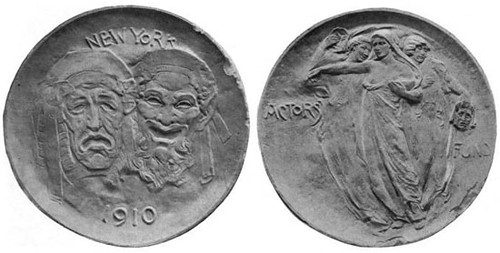
The medals designed by Beach, including the Peace of Versailles medal were often executed in a low relief, making them not as popular of a medalist as some of his contemporaries. Another famous medal were this feature is seen is the 1910 Actors Fund Medal of Honor, which continues to be awarded to this day to individuals and organizations that have enriched the entertainment industry. The design features two comical heads on the obverse, while the reverse features three figures, presumably actors. The first award, in 1910, was awarded to President William H. Taft, while other recipients include Ed Sullivan and Ronald Reagan among others.
To read the complete article, see:
The Life and Work of Chester Beach
(news.coinupdate.com/the-life-and-work-of-chester-beach-4488/)
CLASSICAL NUMISMATIC GROUP LONDON OFFICE MOVING
 After over twenty years in Mayfair, the London office of leading coin dealer and auction house, Classical Numismatic Group (CNG), is moving.
After over twenty years in Mayfair, the London office of leading coin dealer and auction house, Classical Numismatic Group (CNG), is moving.
As of 22nd September 2014, the CNG London team of director Eric McFadden, numismatists Massimiliano Tursi and David Guest, office manager Alexandra Spyra and accounts manager Christina Jordan, look forward to welcoming all clients at the new premises at 20 Bloomsbury Street.
The new office is conveniently located very near the British Museum on the corner of Great Russell Street and Bloomsbury Street, a short walk from the Underground stations of Holborn and Tottenham Court Road in an area of central London well known to the numismatic trade and very much flourishing with the imminent arrival of Crossrail.
All aspects of the CNG business will continue as normal at the new address. Telephone and fax number will remain the same.
Classical Numismatic Group (Incorporating Seaby Coins) 20 Bloomsbury Street London WC1B 3QA
Telephone 00 44 (0) 207 495 1888 Fax 00 44 (0) 207 499 5916 Email cng@cngcoins.com
THE BOOK BAZARRE
NEWMAN CHALMERS THREEPENCE, SIXPENCE AND RINGS
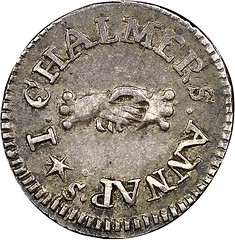
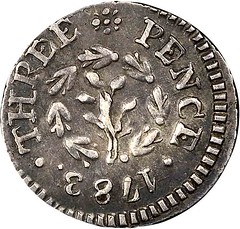
1783 Chalmers Threepence AU50 NGC. CAC. Breen-1018, W-1760, R.5. 10.8 grains, 94% silver, 5% copper, per NGC metallurgical tests. John Chalmers of Annapolis issued silver threepence, sixpence, and shillings dated 1783, likely to alleviate a shortage of coinage, and as a response to the refusal of the local population to accept lightweight Spanish bits that were literally cut from Spanish milled dollars. Who could blame the citizens when unscrupulous individuals would cut five "fourths" or nine "eighths" out of a single dollar?
Judging from the condition of most survivors, the Chalmers silver coins were well-received and circulated extensively, despite the estimated 8% profit that Chalmers earned on the venture, according to numismatic researcher and author Philip Mossman. Perhaps his reputation as a community leader and former Continental Army captain aided the circulation of the Chalmers silver coins.
Annapolis, Maryland, planned in 1694, was an upper-class town of brick mansions and polished society, according to an 18th century British official. The town was also a political center that served briefly as home to the U.S. Congress in late 1783 and the first half of 1784. John Chalmers operated his silversmith business in that setting, having an interest in politics and economics. That was the environment of his silver coinage. Will Nipper writes in his book In Yankee Doodle's Pocket: "They may have been advertising pieces, political statements or simply a means of satisfying his customers' need for coinage. The exact reason for their existence is unknown."
The threepence are clearly rarer than the shillings, but they are seen more frequently than the sixpence. This example has splendid pewter-gray surfaces with light silver devices and traces of peripheral champagne toning. The strike is imperfectly centered, although most of the obverse border details are visible.
Ex: Eric P. Newman Numismatic Education Society.
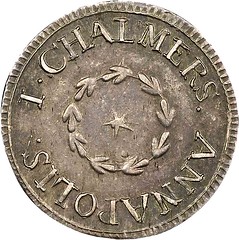
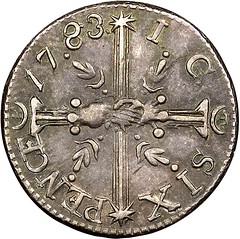
1783 Chalmers Sixpence, Large Date AU55 NGC. CAC. Breen-1013, W-1765, R.7. 29.3 grains, 91% silver, 9% copper, per NGC metallurgical tests. A period, actually part of the ornamentation, divides the date on this rare Chalmers sixpence variety. The Chalmers sixpence are possibly the least understood issues of the Annapolis silver series. The denomination is rarer than either the threepence or shilling, the four recorded varieties are often confused, and the rarities of each are frequently misstated. The Whitman Encyclopedia of Colonial and Early American Coins lists four distinct varieties of the Chalmers sixpence. The combined rarity ratings as published there suggest a total surviving population of 38 to 68 pieces.
The W-1765 variety is recorded in the Whitman reference as "URS-2 or 3 (?)" suggesting that two to four examples are known. It is our opinion that the actual population ranges from eight to 10 pieces, based on several auction appearances, including some possible misattributions. Two of the three examples illustrated at the PCGS Coin Facts website are from this die pair.
This extraordinary example is the finest Chalmers sixpence that we have handled, and it is finer than any others that have appeared in recent times, to the best of our knowledge. The next finest sixpence that we are aware of is an XF45 PCGS example of this same variety that is illustrated at PCGSCoinFacts.com. The present sharply detailed piece has exceptional silver-gray surfaces with blue and gold accents.
The clasped hands at the center of the cross are nicely delineated. This remarkable Chalmers sixpence may qualify as one of the finest surviving representatives of the rare denomination.
Ex: Eric P. Newman Numismatic Education Society.
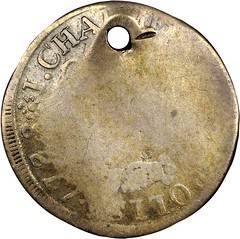
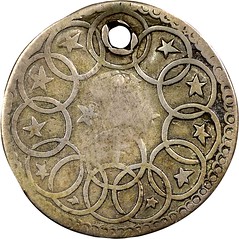
1783 Chalmers Shilling, Rings--Holed--NGC Details. AG. Breen-1010, W-1795, R.7. 52.5 grains, 91% silver, 8% copper, per NGC metallurgical tests. There are only five known examples of this extremely important Chalmers variety, including this example, the Lauder coin that is plugged,, one from the Norweb Collection (donated by the family to the Smithsonian Institution), the Garrett piece, and the Mickley-Ford example that was the only one known to Crosby, who wrote: “The shilling first to be described is supposed to be unique. … At the sale of the Mickley collection (No. 2527,) it brought fifty dollars: as its present owner is unknown to us, no further particulars regarding it can be given.”
The obverse of the Rings shilling has the central cursive inscription “Equal to One Shi” above clasped hands, with the date and peripheral legend I. CHALMERS ANNAPOLIS. The reverse has a circle of 12 intertwined rings with a 13th ring inside the circle at the bottom. Stars appear inside 11 of the 12 outer rings, with a Divine Eye, a Liberty cap on a pole, and two additional stars at the center.
Ex: "Colonel" E.H.R. Green; Green Estate; Partnership of Eric P. Newman / B.G. Johnson d.b.a. St. Louis Stamp & Coin Co.; Eric P. Newman @ $25.00; Eric P. Newman Numismatic Education Society.
For more information, see:
2014 November 14 - 16 Selections from the Eric P. Newman Collection Part V US Coins Signature Auction - New York #1215
(coins.ha.com/c/auction-home.zx?saleNo=1215)
WILLIAM WEIMER
Regarding Joanne Conti's request for information on collector Bill Weimer, John Lorenzo writes:
I just remember his name as a collector of U.S. Colonial coins He never published anything that crossed my library. My U.S. Colonial Coin library sold in 2008 via C. Davis. He was an avid Colonial Coin enthusiast and his pedigree is seen time to time in New Netherland sales.
Pete Smith writes:
I was introduced to Bill Weimer by Dick Punchard sometime in the 1980’s. Dick hosted occasional meetings in Minneapolis for local EAC members and Bill drove up from Rochester, Minnesota. During the period around 1984 to 1986, our core group included Dick, Wes Rasmussen, Bill Weimer and me.
I recall that Bill was working on his set of middle date cents. He worked in technology education at the IBM plant in Rochester. He said that IBM stood for “I’ve been moved.”
At the time, I collected “dominoes.” Here is how that worked. Wes would buy an MS-63 to upgrade his AU-50. He would sell the AU-50 to Bill to upgrade his VF-35. Bill would sell the VF-35 to Dick to upgrade his VF-20. Dick would sell the VF-20 to me to upgrade my VG-8. Since there was nowhere else for the dominoes to fall, I was stuck with the VG-8 as a duplicate.
In 1986 I was working for the Minneapolis school district and served on a committee to recommend the purchase of a computer system to handle word processing. We were looking for a group of small computers linked through a network to a large computer. Such networking was not common at that time.
IBM made large computers with one operating system and small computers with a different operating system. They invited our group to visit Rochester and see how they could get the two systems to communicate. The demonstration did not go well. Anyway, Bill joined us for lunch at IMB that day. He was not part of the sales team but joined us because he knew me.
Bill sold his library through Cal Wilson on January 16, 1987. He sold his large cents through Kagin’s on February 12, 1987. He was transferred out of state again by IBM and I lost touch.
When I Google his name today, I find that a William A. Weimer wrote a book, Who’s That Clown at My Desk? in 2006. The bio for the author says that he was in Human Resources and technology education for IMB. That fits.
The author bio says that William A. Weimer was born in 1934 in Freeport, Illinois. He graduated from Purdue and worked for IBM from 1956 to 1989. At last report he was retired and living in Asheville, North Carolina.
To read the earlier E-Sylum article, see:
NOTES FROM E-SYLUM READERS: SEPTEMBER 14, 2014 : Query: William Weimer Information Sought
(www.coinbooks.org/esylum_v17n38a09.html)
EMPEROR NORTON'S GARDEN PARTY
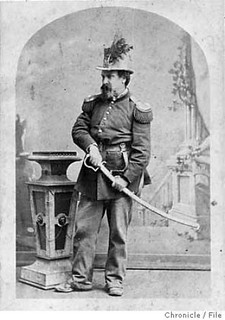 On 17 September 1872, Emperor Norton penned the third and final of his three "bridge proclamations" of that year, in which he set out the vision for what we now know as the San Francisco-Oakland Bay Bridge.
On 17 September 1872, Emperor Norton penned the third and final of his three "bridge proclamations" of that year, in which he set out the vision for what we now know as the San Francisco-Oakland Bay Bridge.
The proclamation was published on 21 September.
Thirteen years earlier — on 17 September 1859 — Joshua Abraham Norton had issued his most famous Proclamation of all: the one declaring himself Emperor and signed "Norton I, Emperor of the United States."
Please join THE EMPEROR'S BRIDGE CAMPAIGN in celebrating these two anniversaries — the Emperor's third Bridge Proclamation (142 years ago) and his imperial self-declaration (155 years ago) — with a lovely, fun afternoon in the park.
The Emperor's Garden Party
Sunday 21 September from 2 to 5 p.m.
Jefferson Square Park
Eddy St., between Gough & Laguna
San Francisco
A SPECIAL WELCOME TO KIDS — We've got some fun activities planned!
2 to 3:15 P.M. >>> Make Your Own Emperor's Hat
Starting at 2 o'clock, we'll have a hat-making station, where kids will be shown photos of the Emperor in his beaver hat and will be provided with construction paper, crayons, glitter and feathers, for making making and decorating their own "Emperor's hats"! --- with adult assistance, of course.
3:15 P.M. >>> The Emperor's Story Time
The kids will gather round, in their hats, to hear Emperor Norton himself — played by Joseph Amster of Emperor Norton's Fantastic San Francisco Time Machine
3:30 P.M. >>> The Emperor's Parade
After The Emperor's Story Time, Emperor Norton will lead the kids — in their hats! — in a little parade around Jefferson Square Park.

Emperor Norton discussing his scrip

Emperor Norton buying beers with his scrip
To watch the video blog, see:
Overland Monthly 1- Emperor Norton
(www.youtube.com/watch?v=h852nCp_rls)
For more information on the Norton impersonator's tour, see:
Emperor Norton's Fantastic San Francisco Time Machine
(www.emperornortontour.com)
For more information on the Emperor's Bridge campaign, see:
www.emperorsbridge.org/
To read the earlier E-Sylum articles, see:
EMPEROR NORTON'S BRIDGE
(/www.coinbooks.org/esylum_v17n23a36.html)
MORE ON THE EMPEROR NORTON BRIDGE CAMPAIGN
(www.coinbooks.org/esylum_v17n24a25.html)

QUERY: SAMUEL JOHNSON'S GOLD MEDALLION
It's the birthday of Samuel Johnson (books by this author), born in Litchfield, England (1709). He was a sickly boy, and had been since the day he was born — "almost dead," he said. He contracted the lymphatic form of tuberculosis, called scrofula, when he was two, and because it was popularly believed that the touch of royalty could cure scrofula, he was taken to the queen. She touched him and gave him a gold medallion, which he kept for the rest of his life. Her touch didn't cure him, and neither did various disfiguring treatments that left him scarred. But he grew up strong and tall, and enjoyed walking, swimming, and riding. He was also very intelligent, proud, and somewhat lazy.
In 1735, he married a widow who was 20 years his senior. He set out to find an intelligent wife, since he was convinced that his parents' marriage had been unhappy because of his mother's lack of education. Around this time, he also started writing. He published some essays early in the 1730s, and began a play, the historical tragedy Irene. In 1738, he became associated with the first modern magazine — called The Gentleman's Magazine — and contributed poems and prose.
The 1750s were his most productive period. Not only did he write more than 200 essays for the twice-weekly newspaper The Rambler, but he was also at work on a monumental undertaking: a dictionary of the English language. The dictionary took him nine years to write
To read the complete article, see:
The Writer's Almanac Thursday Sep. 18, 2014
(writersalmanac.publicradio.org/index.php?date=2014/09/18)
BULGARIAN FIND OF ANCIENT ELECTRUM COIN FROM LYDIA
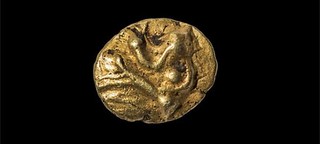 A diver has found what is believed to be the oldest gold coin ever discovered in Bulgaria, Bulgarian news agency BTA reported on September 9. The coin was found in shallow waters near the resort town of Sozopol on Bulgaria’s Black Sea coast.
A diver has found what is believed to be the oldest gold coin ever discovered in Bulgaria, Bulgarian news agency BTA reported on September 9. The coin was found in shallow waters near the resort town of Sozopol on Bulgaria’s Black Sea coast.
The diver saw the gleaming coin by accident, the report said, and later passed it on to Bozhidar Dimitrov – a native of Sozopol and former diver himself, who is now head of the National History Museum in Sofia.
BTA quoted numismatist Vladimir Penchev from the National History Museum saying that the coin is not solid gold, but made of electrum – the naturally occurring alloy of gold and silver, used to mint some of the earliest metal coins in human history.
This particular coin appears to have been minted in the kingdom of Lydia in western Anatolya, sometime in the second half of the seventh century BCE, which put the coin’s age at more than 2750 years, he said.
The coin weighs 0.63 grams and has a denomination of 1/24 of a stater.
To read the complete article, see:
Diver finds 2750-year-old gold coin in Bulgaria
(sofiaglobe.com/2014/09/09/diver-finds-2750-year-old-gold-coin-in-bulgaria/)
THE BOOK BAZARRE
3D PRINTED BOOK OF BAS RELIEF
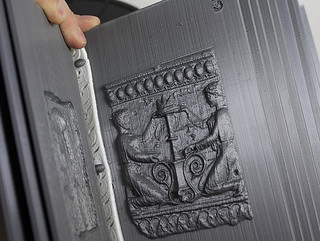 Tom Burtonwood sez, "I have just published Folium, a 3D printed book of bas relief from the Art Institute of Chicago; it's posted to thingiverse for download: 12 pages, 9 scans featuring works of art spanning over 2000 years, from the Ancient Egyptians to Louis Sullivan department store decorations."
Tom Burtonwood sez, "I have just published Folium, a 3D printed book of bas relief from the Art Institute of Chicago; it's posted to thingiverse for download: 12 pages, 9 scans featuring works of art spanning over 2000 years, from the Ancient Egyptians to Louis Sullivan department store decorations."
Burtonwood's last 3D printed book, a collection of textures and reliefs, was also a free download.
In addition to the scans all the texts have also been translated into braille so that low sighted and visually impaired people can experience the reliefs and identify what they are.
To read the complete article, see:
3D printed book of bas relief from Art Institute of Chicago
(boingboing.net/2014/09/15/3d-printed-book-of-bas-relief.html)
MORE ON REPLACEMENT BANKNOTES
Joel Shafer of Lyn Knight writes:
We just concluded its landmark sale of replacement notes, the first ever auction solely dedicated to these fascinating pieces. We are pleased to report that approximately 95% of the material sold! Consistent bidding occurred throughout the sale; a good mix of less and more expensive lots provided excellent opportunities for collectors of every experience level as well as dealers. We are hopeful that this auction will help boost the visibility and market performance of these amazingly diverse and deceptively complex pieces...
One element which renders replacements complex is that what makes a note a replacement for one country is a regular piece for another. For example, many replacements have a serial prefix Z or ZZ; for some issues, Z is a prefix for a regular note. Here are a few examples of various kinds of replacements...enjoy!
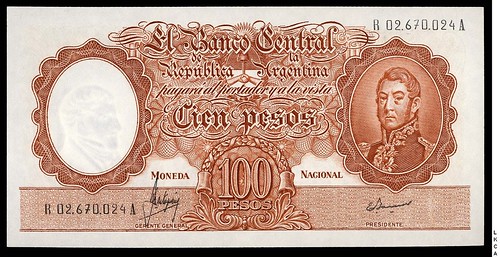
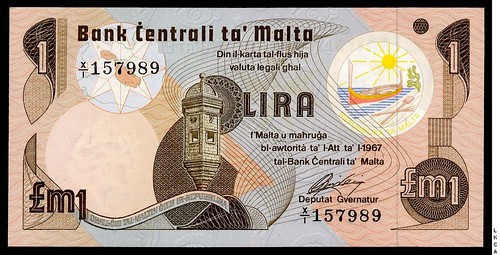
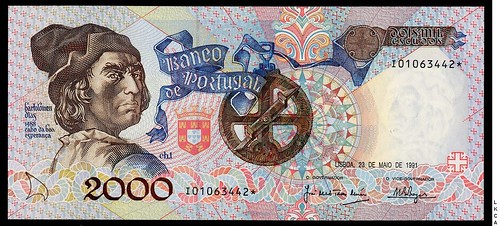
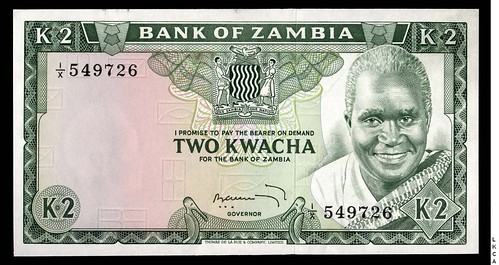
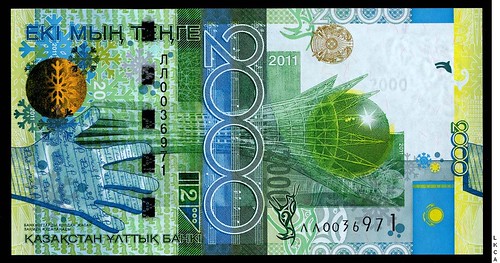


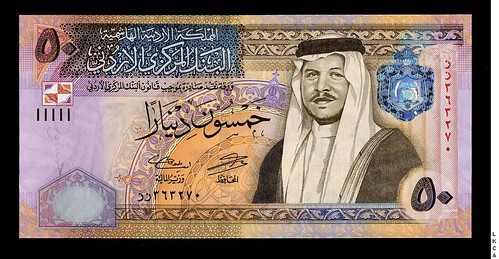
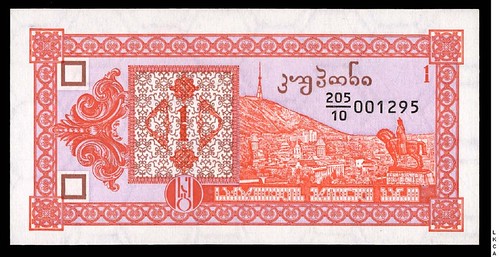
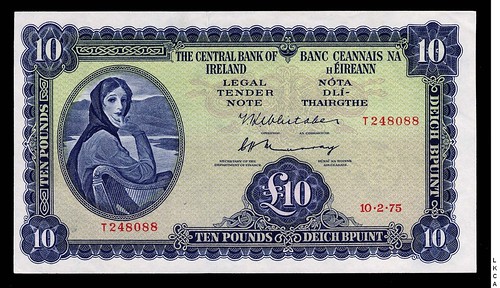
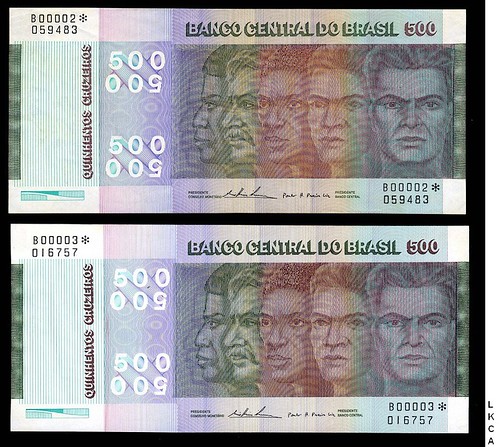
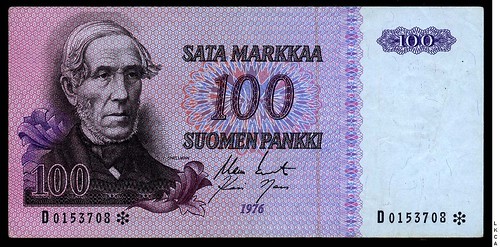
To read the earlier E-Sylum article, see:
THE LYN KNIGHT WORLD REPLACEMENT NOTE SALE
(www.coinbooks.org/esylum_v17n38a17.html)
REPLACING DAMAGED IRISH BANKNOTES
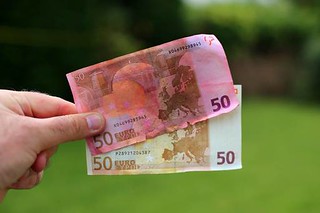 A massive €20m of damaged bank notes, some ruined by washing machines and microwaves, have been replaced by authorities since the start of last year.
A massive €20m of damaged bank notes, some ruined by washing machines and microwaves, have been replaced by authorities since the start of last year.
The Central Bank revealed its note checkers refused 370 applications for new money this year - the vast majority because less than half the original note was handed in.
Among the excuses people have offered for ruined notes are that they tried to dry out soaked or damp cash in a microwave or that they unwittingly put them through a wash and spin cycle.
The Central Bank said €10.7m worth of what it classed as "mutilated notes" were reimbursed last year, while this year €9.9m has been replaced.
Experts in its currency division are reporting more ink-stained notes being handed in over recent years by professional cash handlers, mainly cash-in-transit security companies.
Last year, 195 lots of these dyed notes were replaced by authorities, while 245 applications have been processed this year.
To read the complete article, see:
Wash and gone as €20m in notes are destroyed
(www.independent.ie/irish-news/wash-and-gone-as-20m-in-notes-are-destroyed-30595499.html)

WEDDING COIN TRADITIONS
Brides in Great Britain quite literally wear “something borrowed, something blue, and a silver sixpence in their shoe.” Typically, it’s the father of the bride who places the sixpence in his daughter’s shoe. The ritual is meant to represent the father wishing his daughter luck, wealth, and happiness in her marriage.
In Wales, a silver coin is also placed inside a champagne cork from the wedding ceremony. After the ceremony, the cork with the silver coin is given to the couple as a gift, which serves as a souvenir of the special day.
Sweden
The Swedish coin ceremony is very similar to Great Britain’s. The only difference is the addition of a gold coin. The mother of the bride gives her daughter a gold coin to wear in her shoe in addition to a silver coin from her father. The coins in the shoes are said to ensure that the new marriage is financially sound.
Ireland
Far back in history, an Irish groom would pay what’s known as “luck money” to the family of his bride to be. From this ancient custom, a wedding ritual arose. After exchanging rings, the groom would present the bride with a coin. Today, since the concept of “luck money” has faded from fashion, many couples instead exchange coins with each other. Legend has it that if the coins clink together as they’re exchanged, the couple will have children.
Poland
In the U.S., many people throw some kind of confetti at the bride and groom as they exit. In Poland, however, the wedding guests throw coins instead. The bride and groom then collect all of the coins together. The practice of helping each other gather the coins is said to bring the new couple closer together. Lithuania
In Lithuania, wedding guests bring silver coins with them to throw on the dance floor. One of these coins has the wedded couple’s initials on it. After the first dance is complete, the groomsmen and bridesmaids collect all of the coins. Whoever finds the coin with the initials gets to dance with the bride or groom.
This tradition dates back to a story about an impoverished couple. Unable to afford an engagement ring, the groom proposed with a coin he’d specially carved for his bride to be. But soon after he proposed, he was sent off to war. For ten years, his fiancée waited. When he returned, she’d lost the coin, which must have been disappointing. But they decided to proceed with the wedding anyway.
After his actions in the war, the man had been hailed as a hero. So when the wedding day arrived, the whole community attended to show their support. Seeing that the couple was unable to afford rings for their ceremony, the community rallied around them and collected coins to give to them. Among the coins was the very special “Love Coin” the groom had carved for the bride ten years prior. Legend has it that upon discovering the coin, the overjoyed couple danced with the guest who’d brought it. And that’s how the Lithuanian “Love Coin” tradition was born.
Spain and Latin America
During a traditional Hispanic wedding ceremony, brides are given 13 gold coins as a symbol of their husband’s pledge to care for them financially. This ritual is known as las arras, and can be traced back to ancient Rome where a coin would be broken in half and split between the bride and groom. This practice was known as arrhae, which translates as “pledge.”
To read the complete article, see:
Wedding Coin Traditions from Around the World
(www.kirotv.com/news/lifestyles/shopping/wedding-coin-traditions-around-world/nhNnq/)
COIN-FILLED LUCITE TOILET SEAT
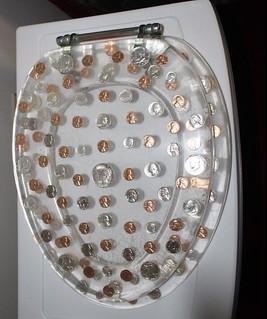 MONEY Toilet Seat REAL US Coins HEAVY Lucite Resin - Great Collector's Item
Excellent Condition, all coins MINT, preserved in resin. Purchased at an estate sale.The oldest coin is a 1922 Peace Dollar. The newest coin is a 1973. See photos for all the coins that come with seat. A worthy investment for any collector. This is for an oval toilet seat.
MONEY Toilet Seat REAL US Coins HEAVY Lucite Resin - Great Collector's Item
Excellent Condition, all coins MINT, preserved in resin. Purchased at an estate sale.The oldest coin is a 1922 Peace Dollar. The newest coin is a 1973. See photos for all the coins that come with seat. A worthy investment for any collector. This is for an oval toilet seat.
On the lid: 1 - 1922 Peace Dollar, 6 - Half Dollars, 7 - Quarters, Nickels and Pennies.
On Seat - 8 - Half Dollars, 6 - Quarters, Nickels and Pennies.
There are some Mercury Dimes, Indian Heads Pennies, Buffalo Nickels.
For the complete eBay listing, see:
MONEY Toilet Seat REAL US Coins HEAVY Lucite Resin - Great Collectors Item
(www.ebay.com/itm/MONEY-Toilet-Seat-REAL-US-Coins-HEAVY-Lucite-Resin-Great-Collectors-Item-/261591648854)
FEATURED WEB PAGE: ORDERS AND MEDALS RESEARCH SOCIETY
This week's Featured Web Page is the Orders and Medals Research SocietyOur Society exists to promote a general interest in the study of orders, decorations and medals and to actively encourage and publish research into all aspects of civil and military medals, with a particular focus on those issued by Great Britain and the Commonwealth countries.
Members' interests range from awards for gallantry in battle, or bravery in saving life, through forgotten wars and far-flung campaigns, to long and meritorious public service away from the limelight. Research interests stretch from pure numismatics, through the military or social history surrounding the circumstances of awards, to the genealogy of the medal recipient.
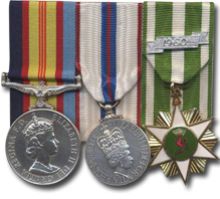
www.omrs.org.uk

